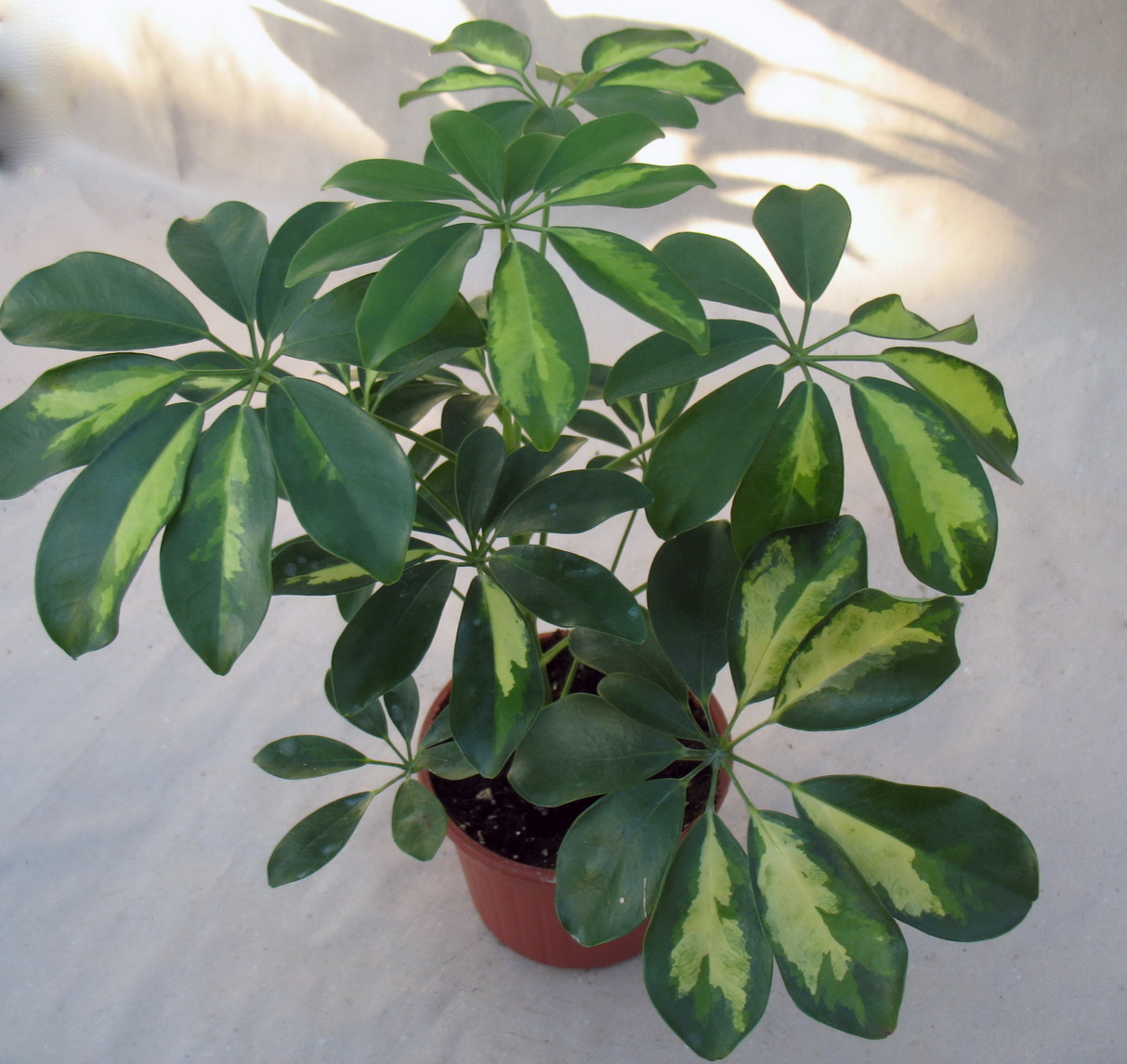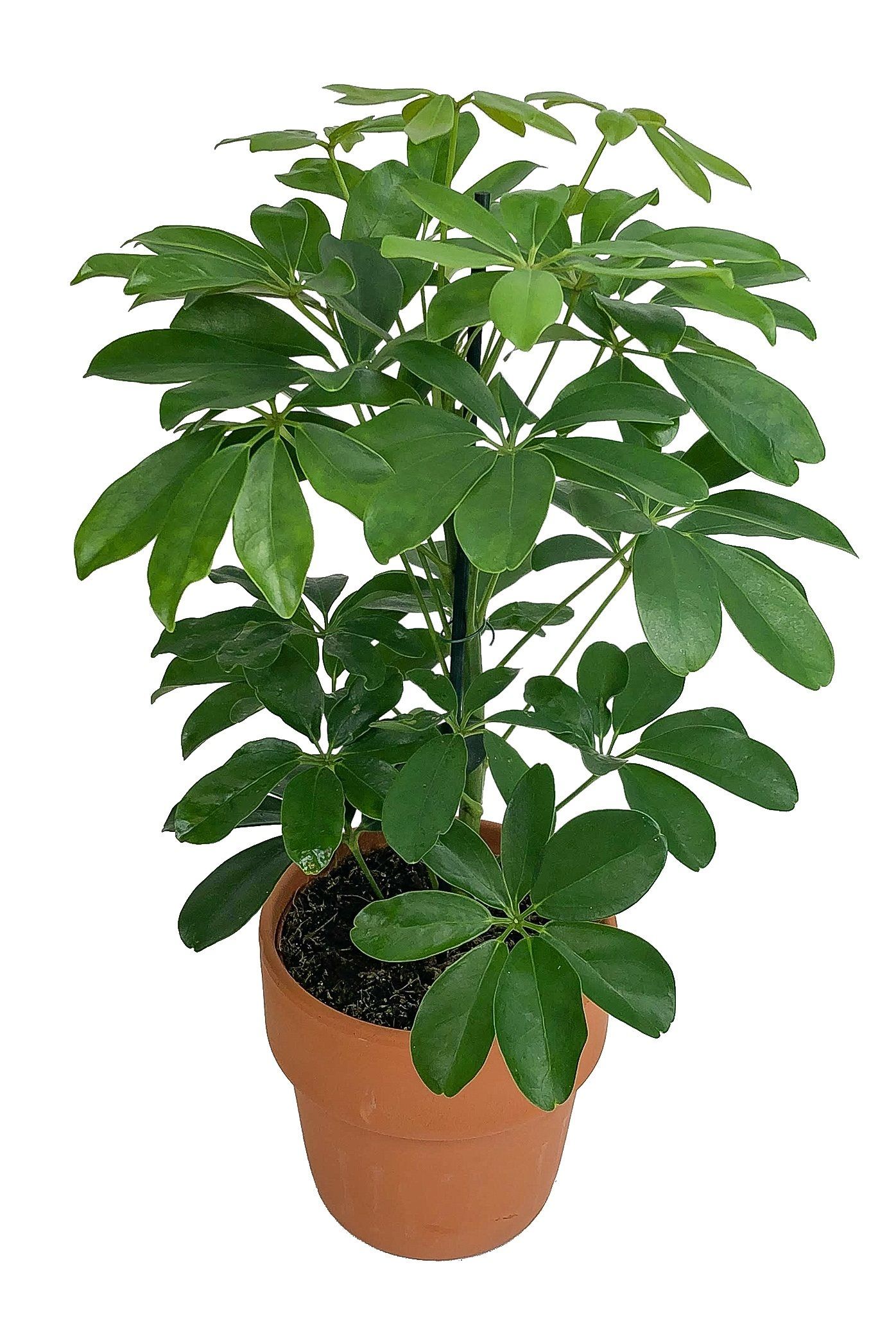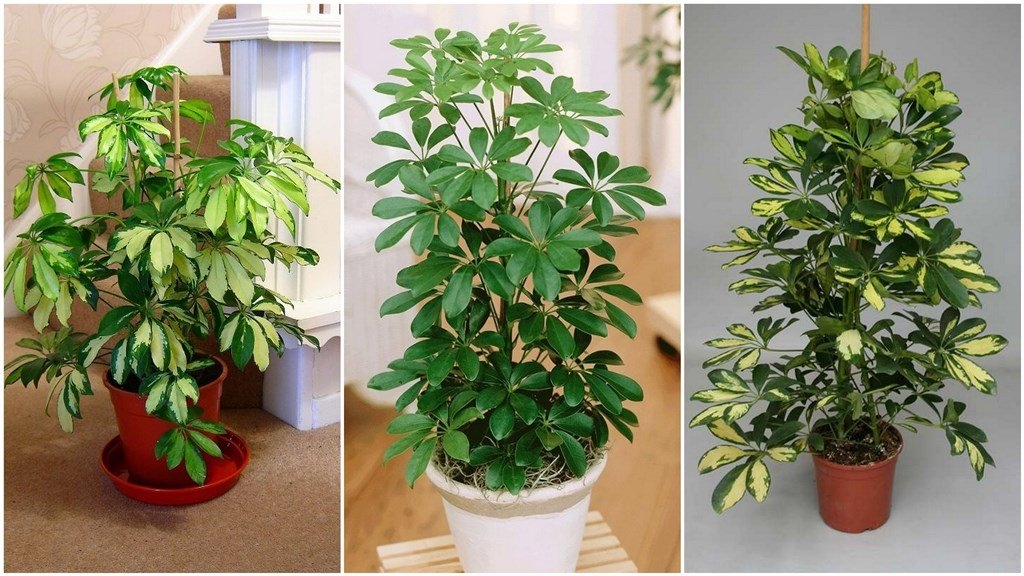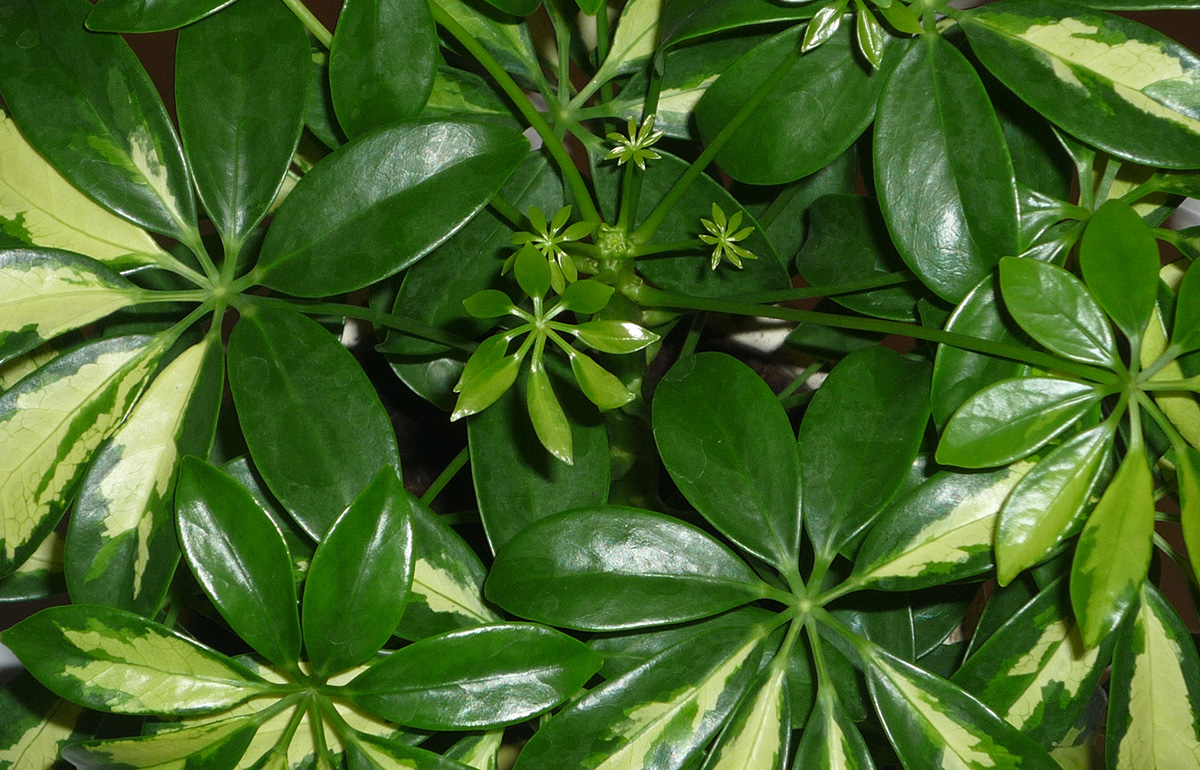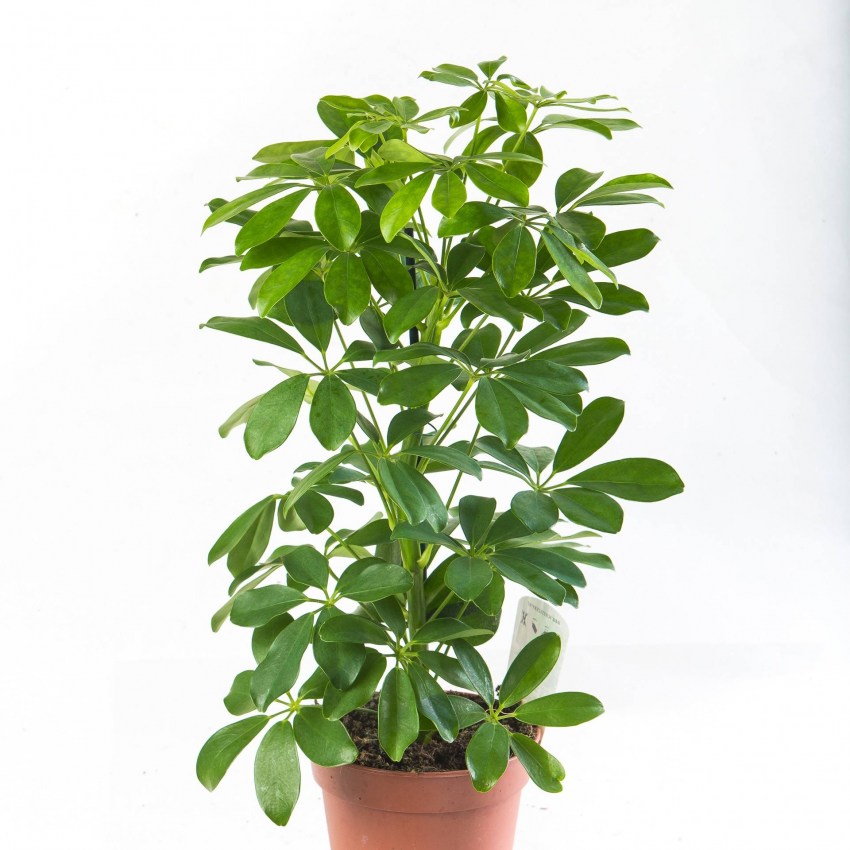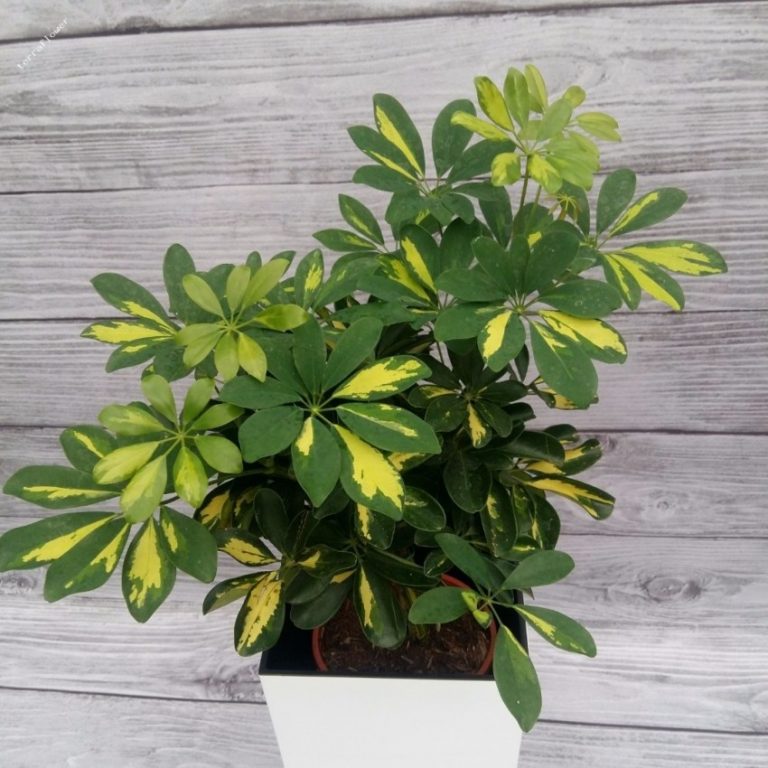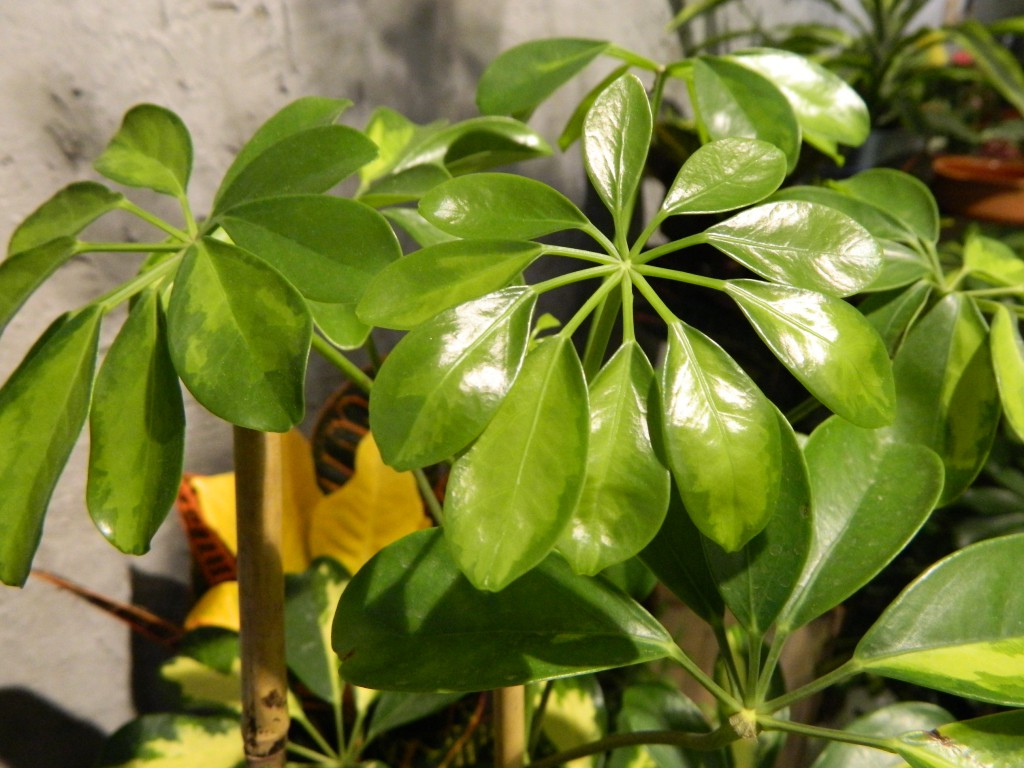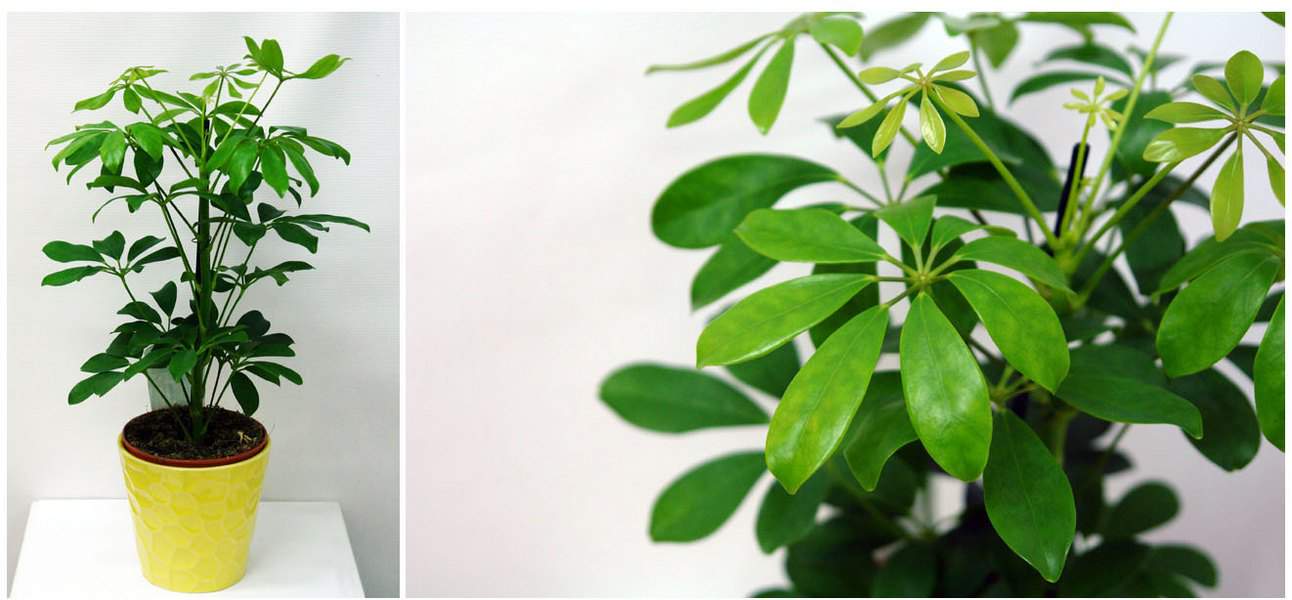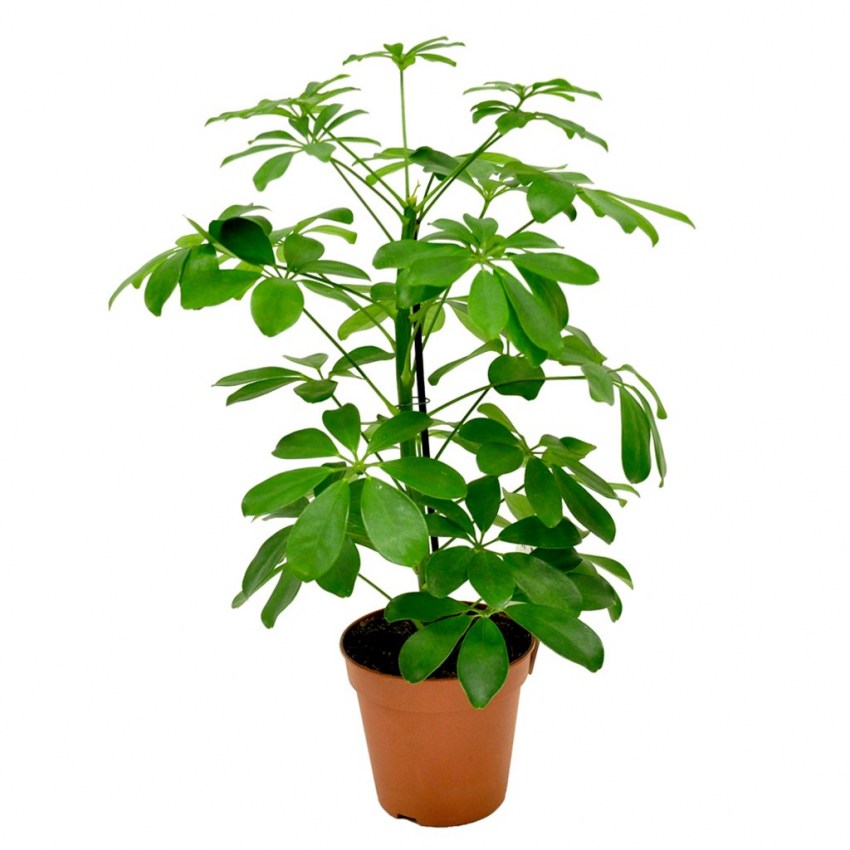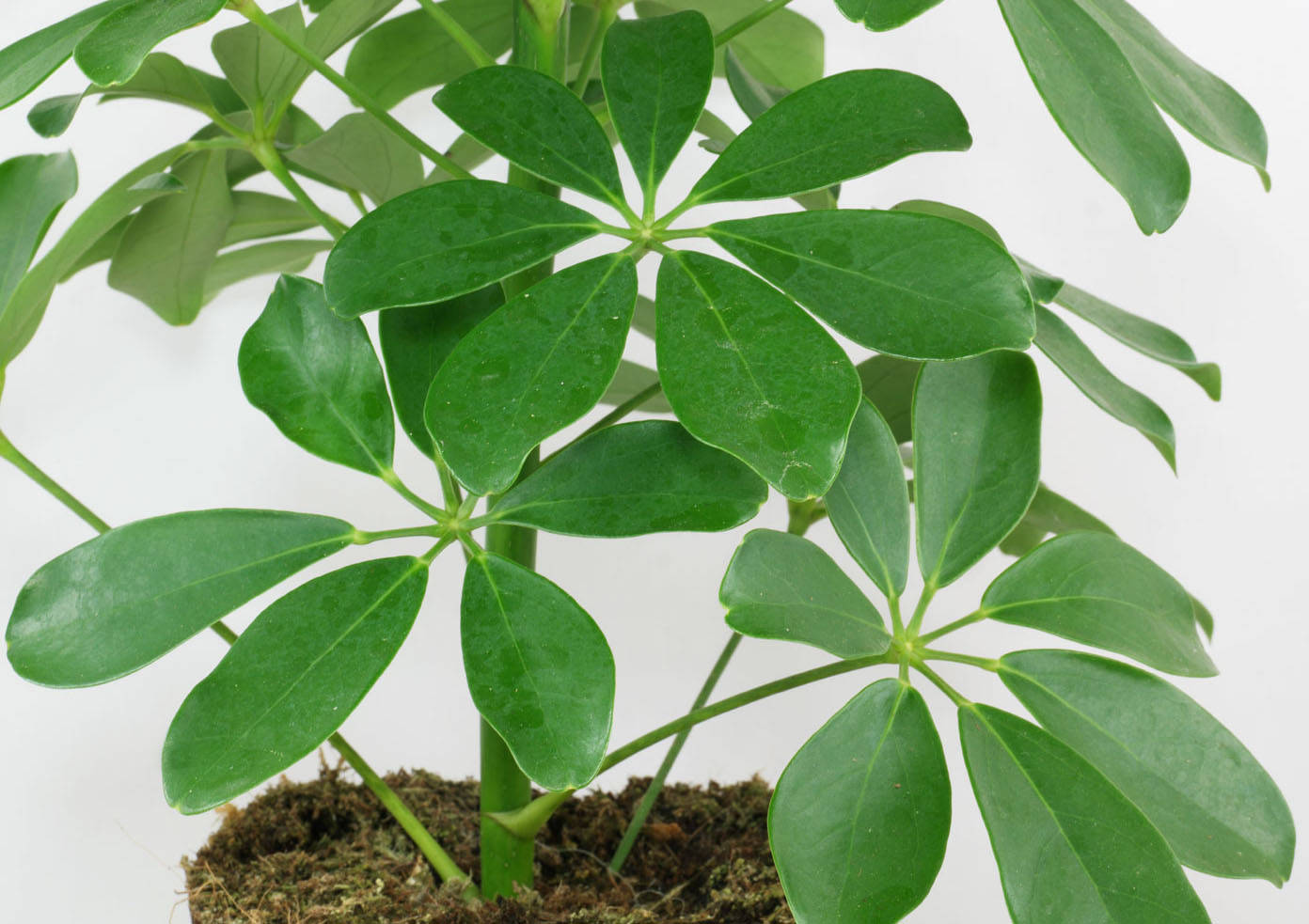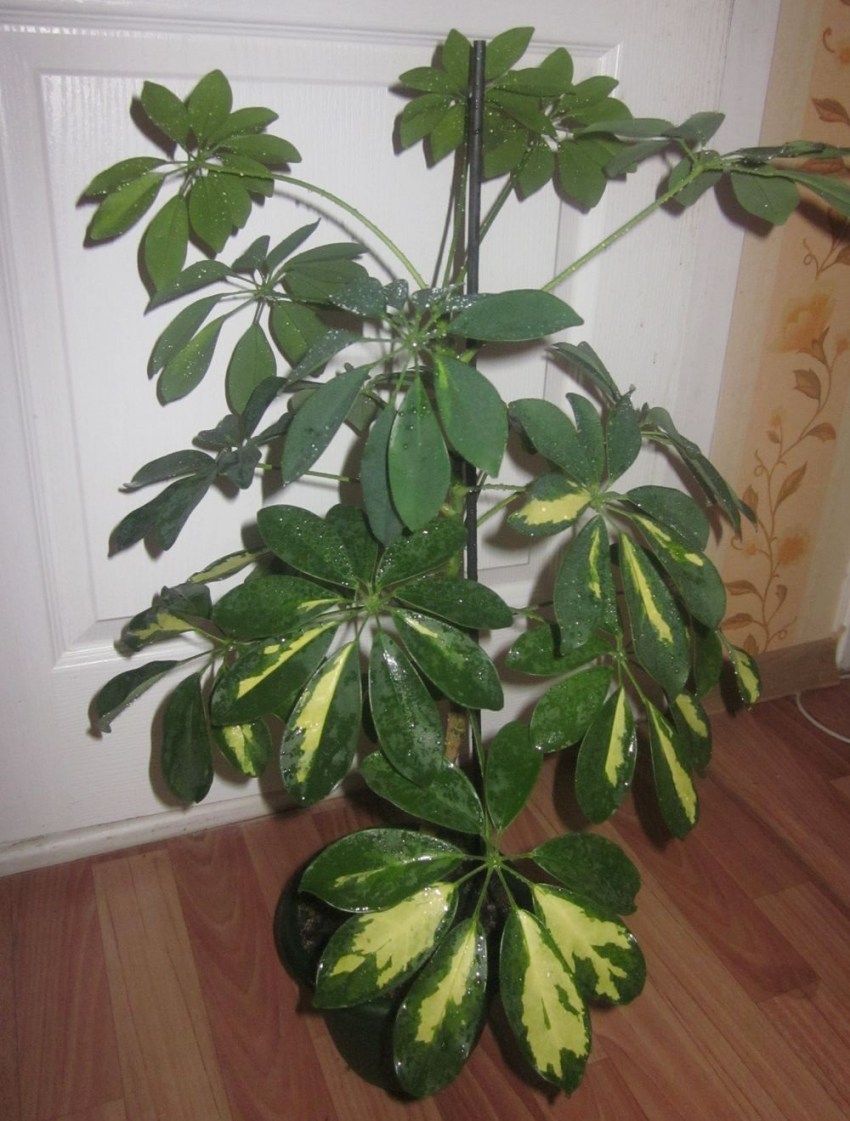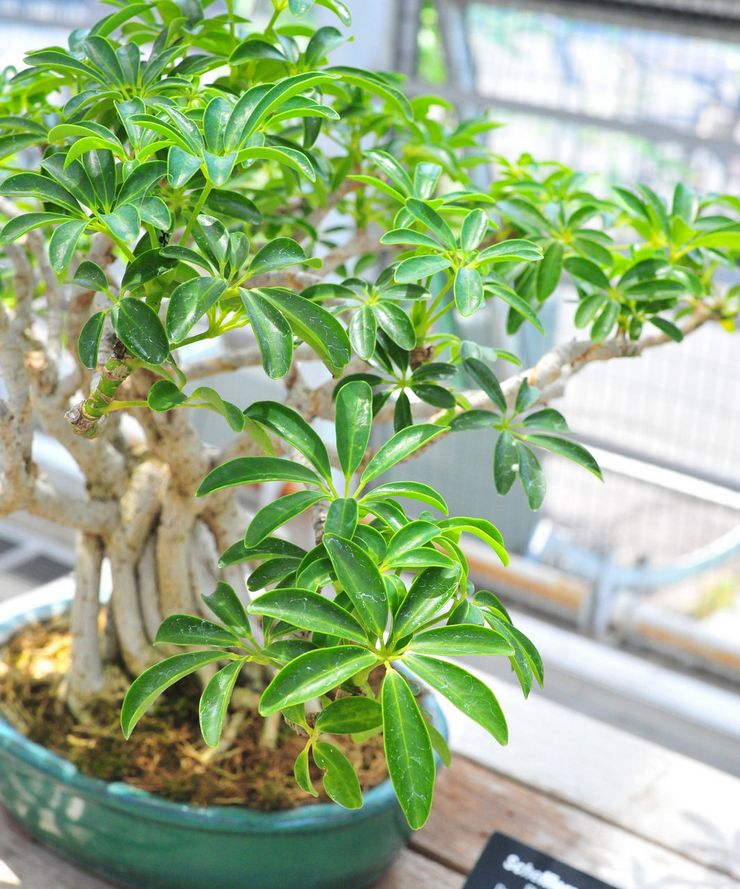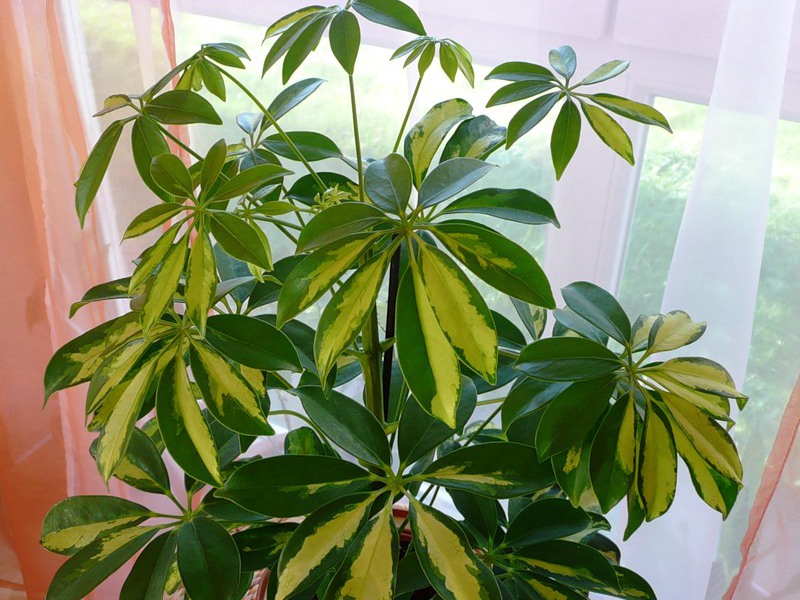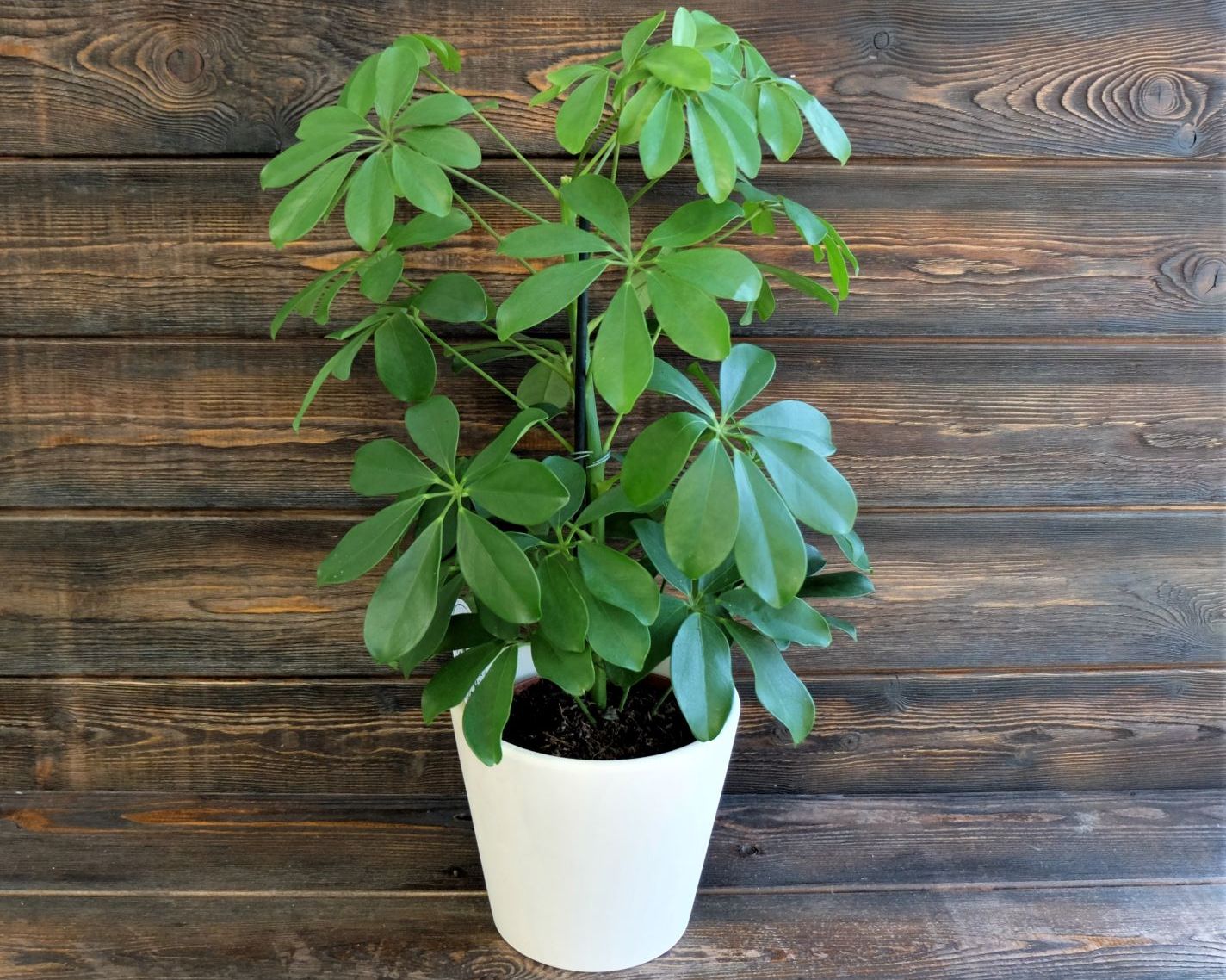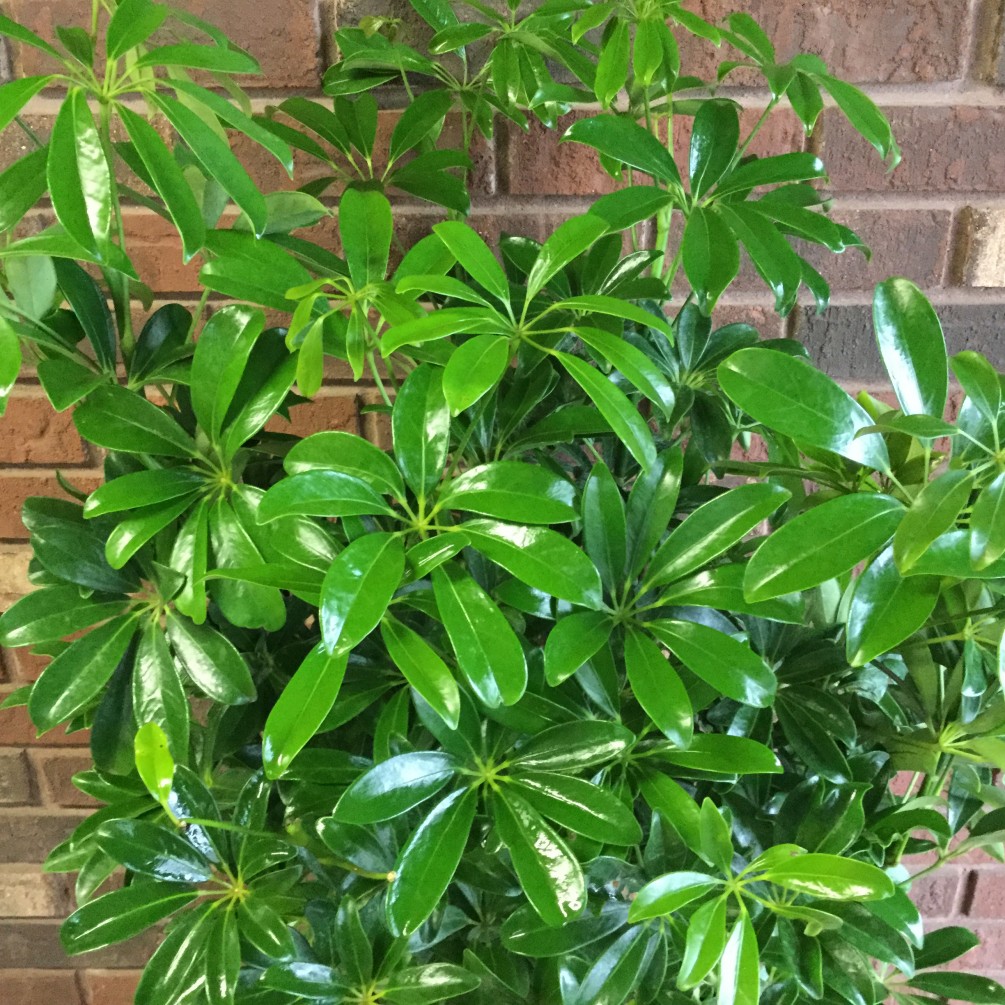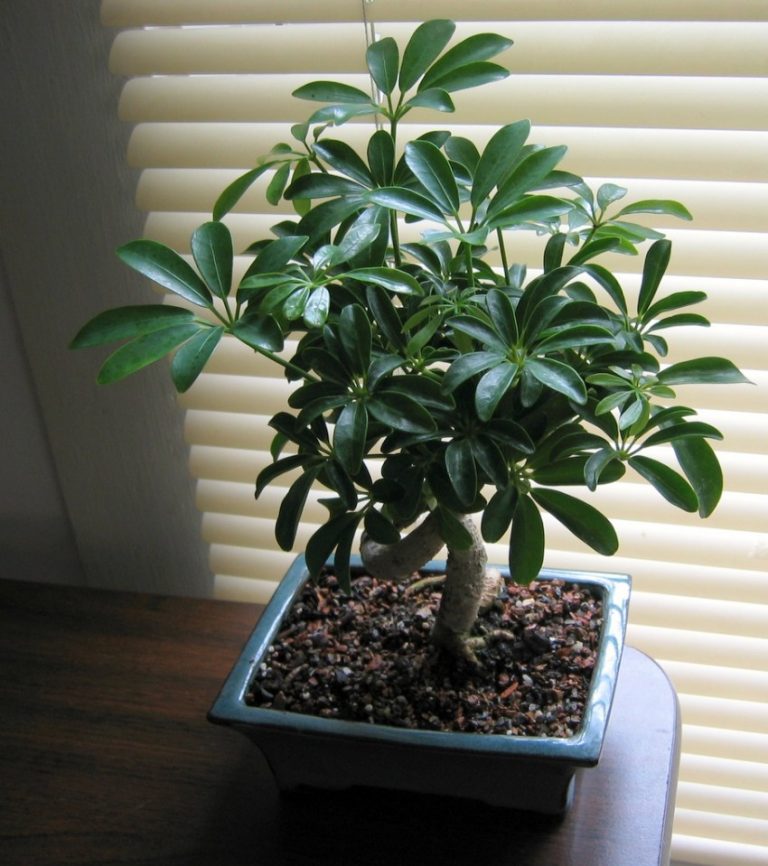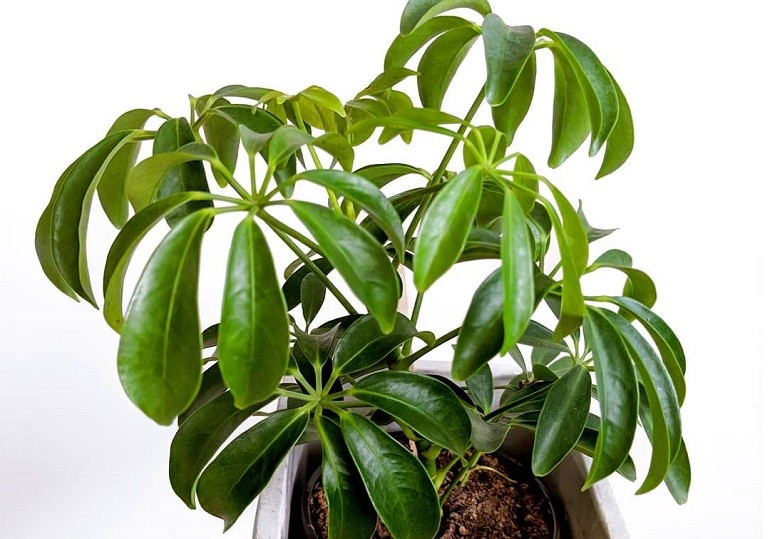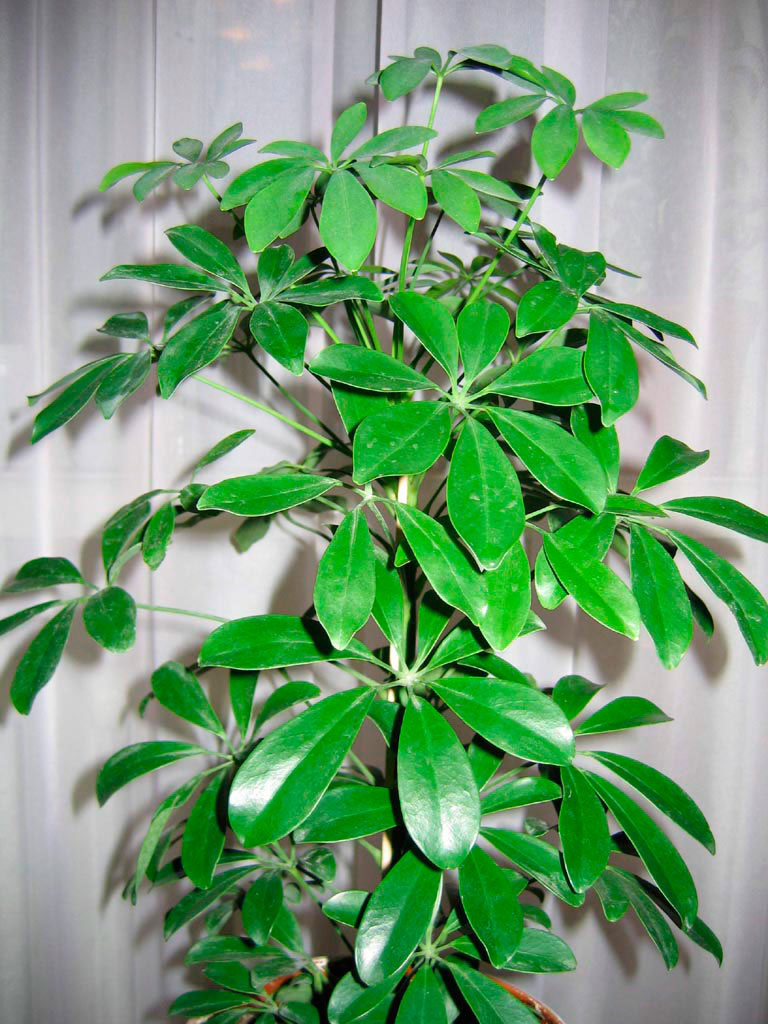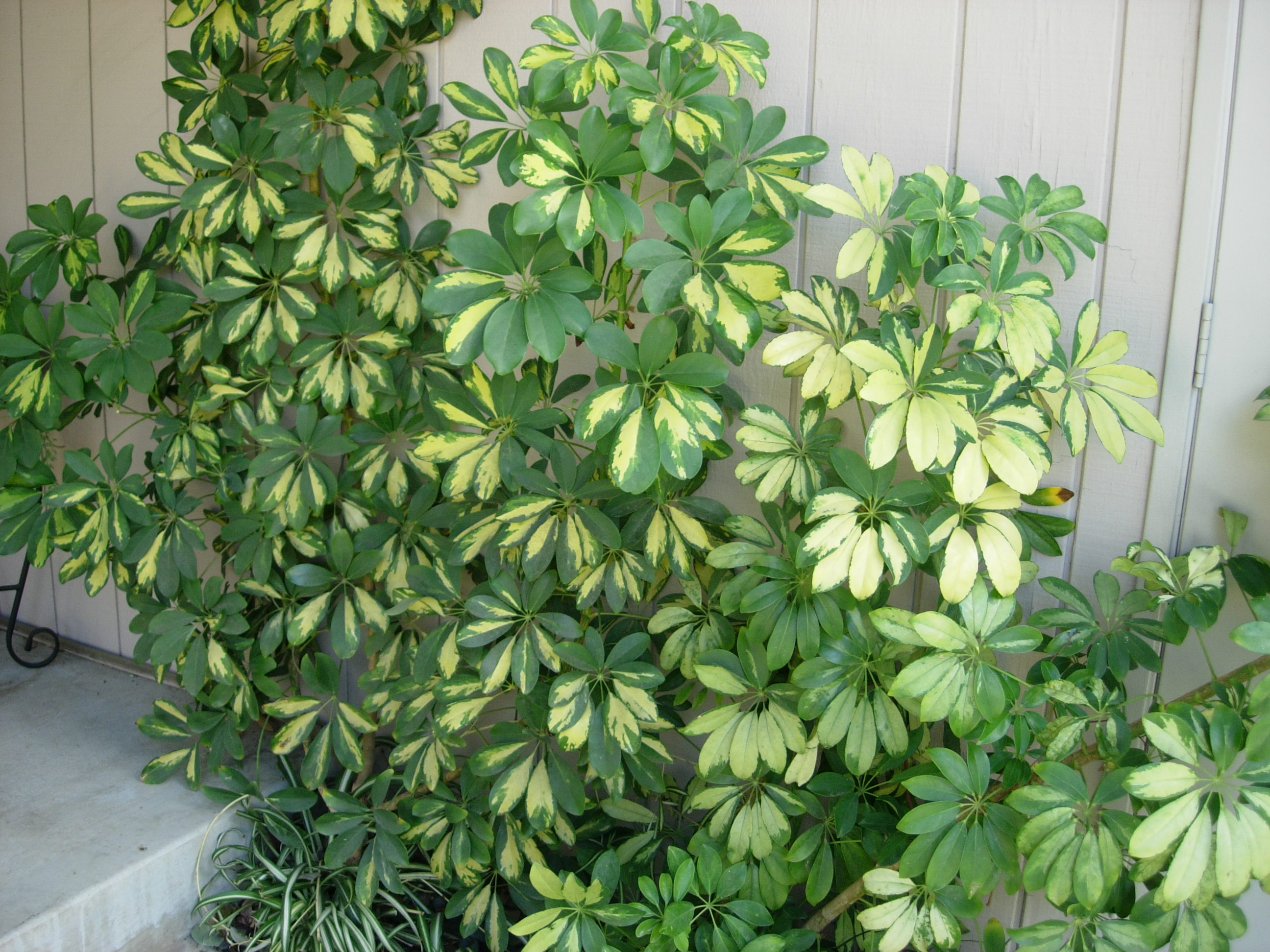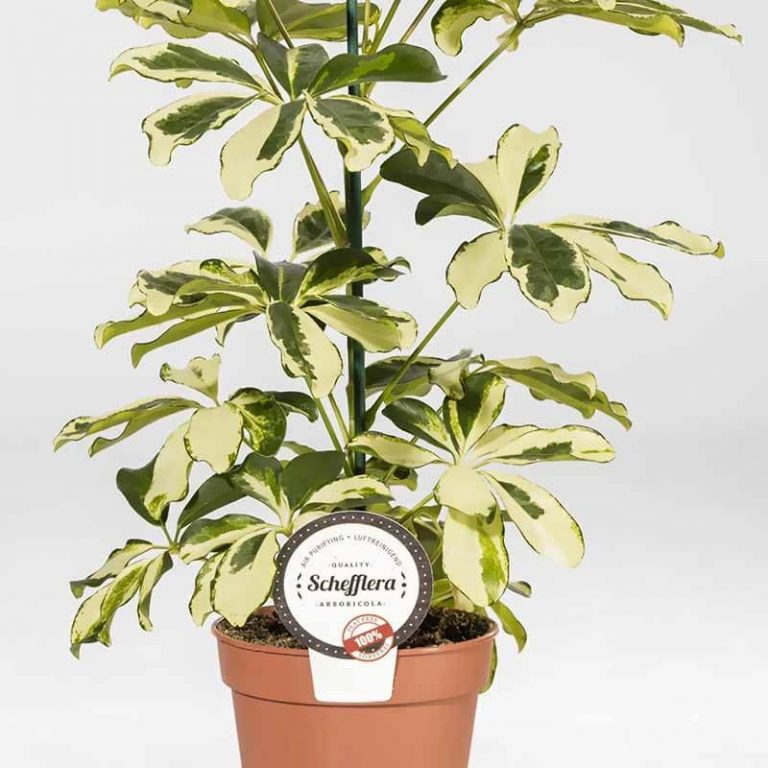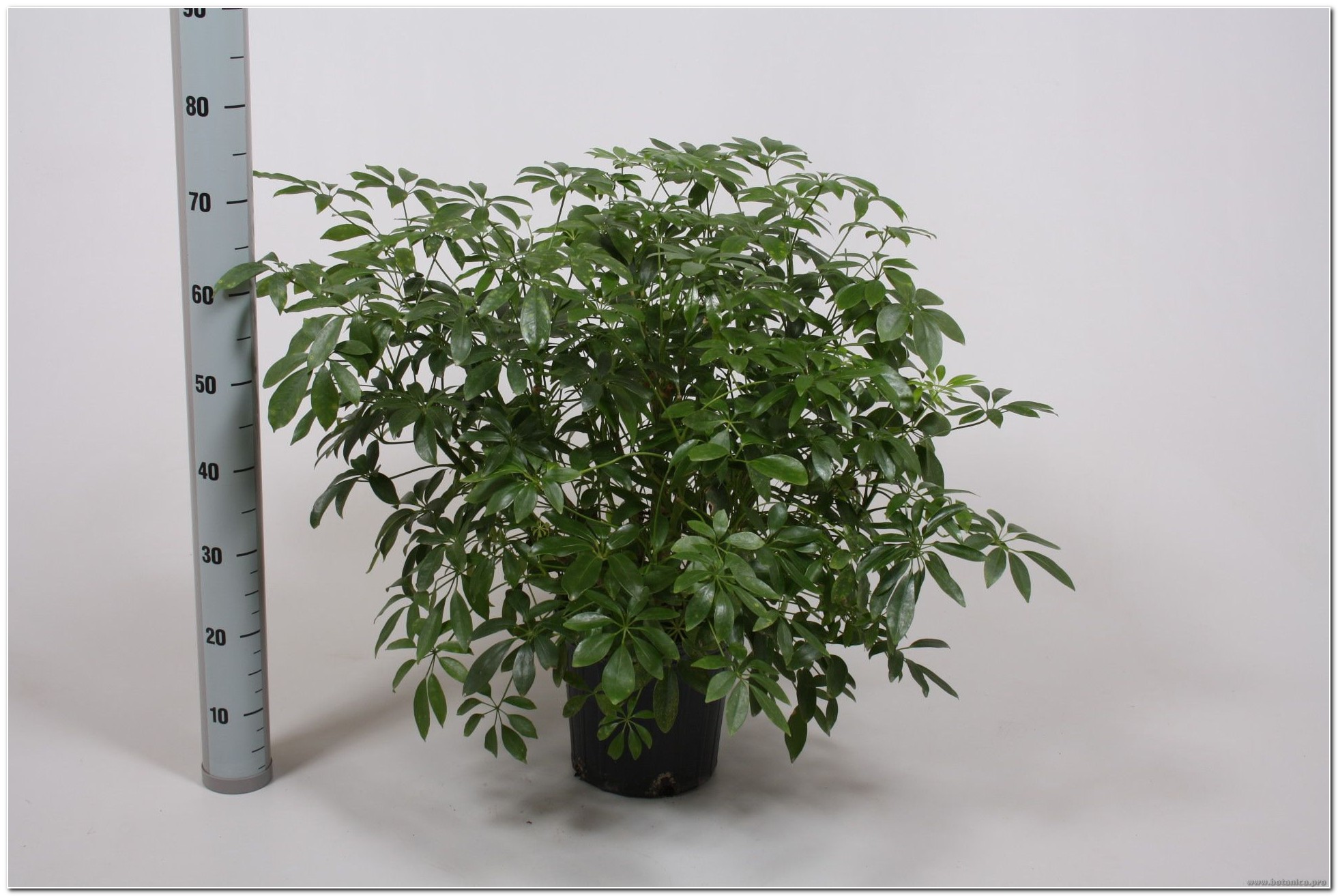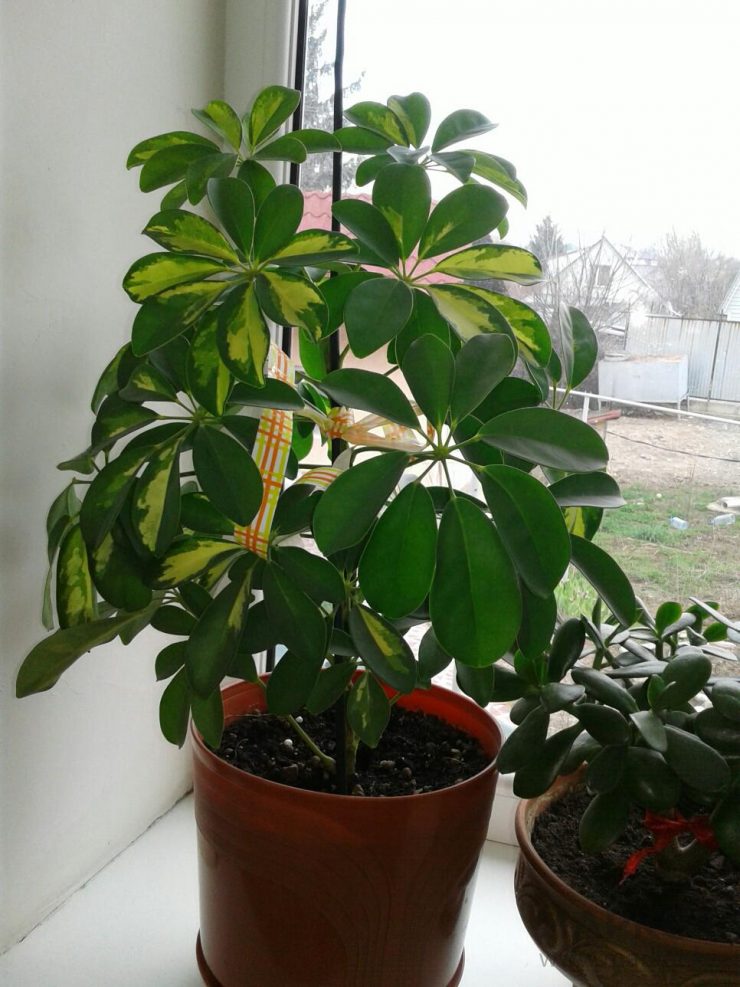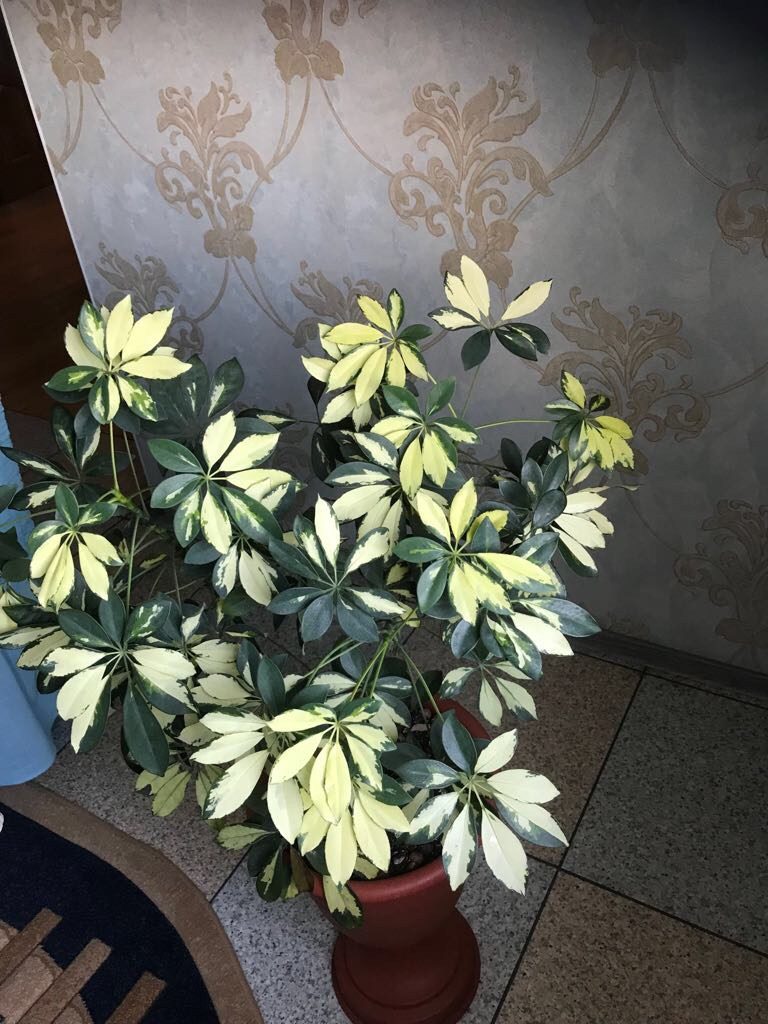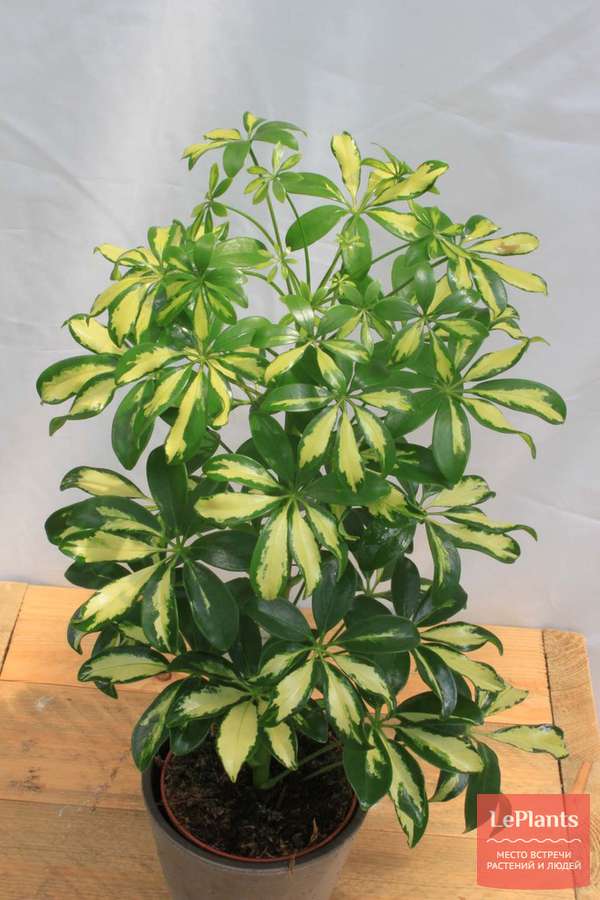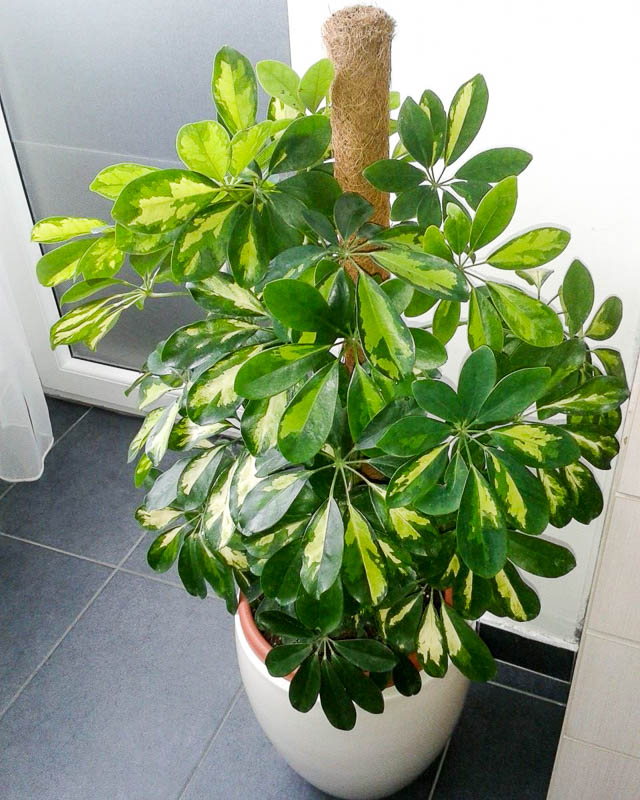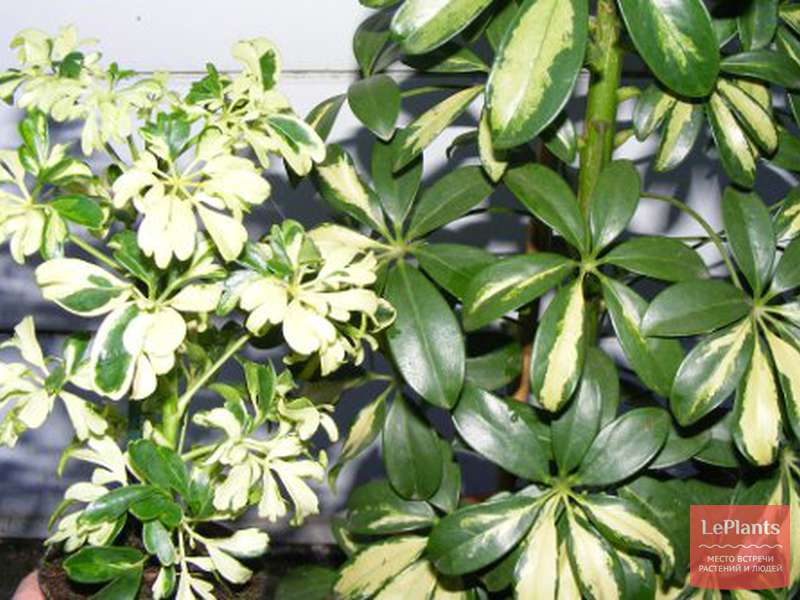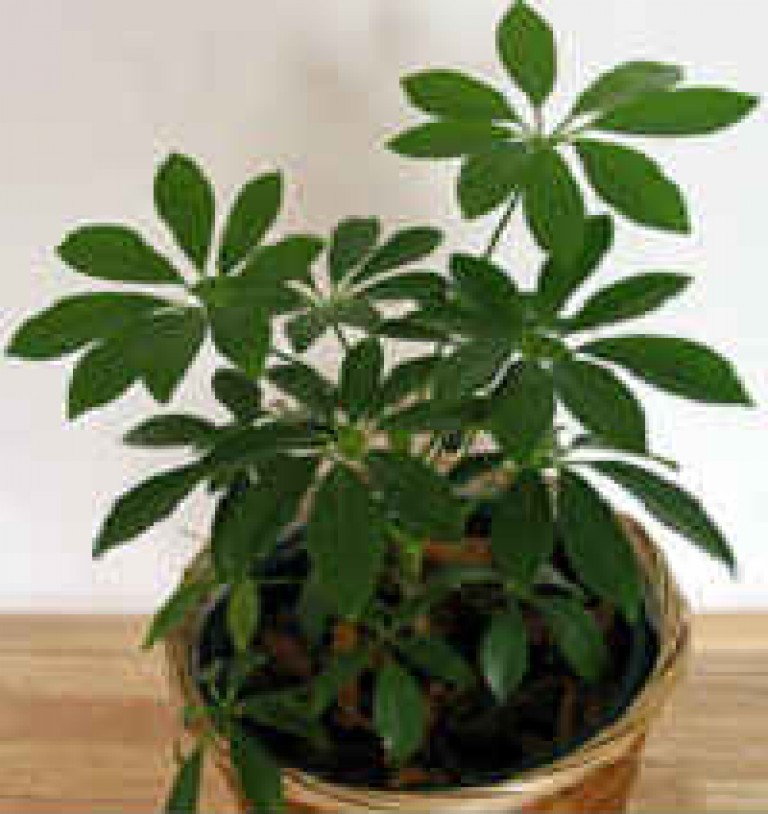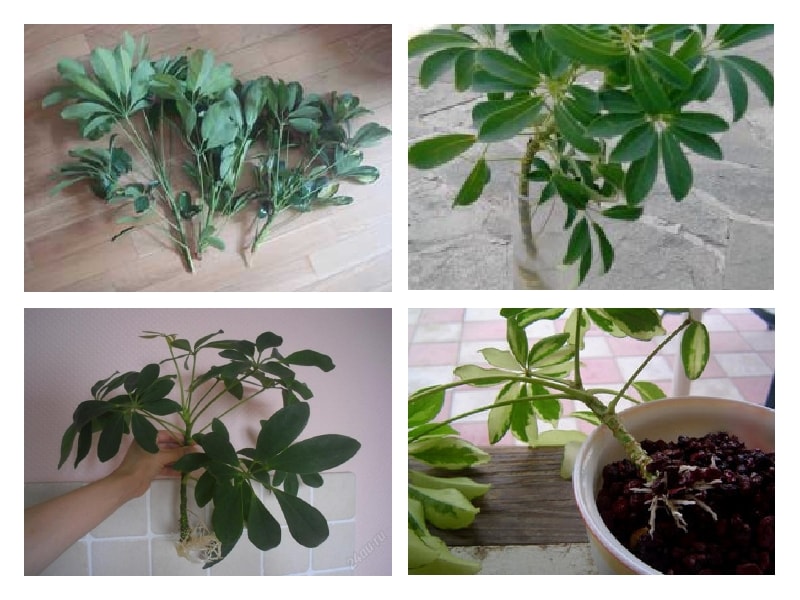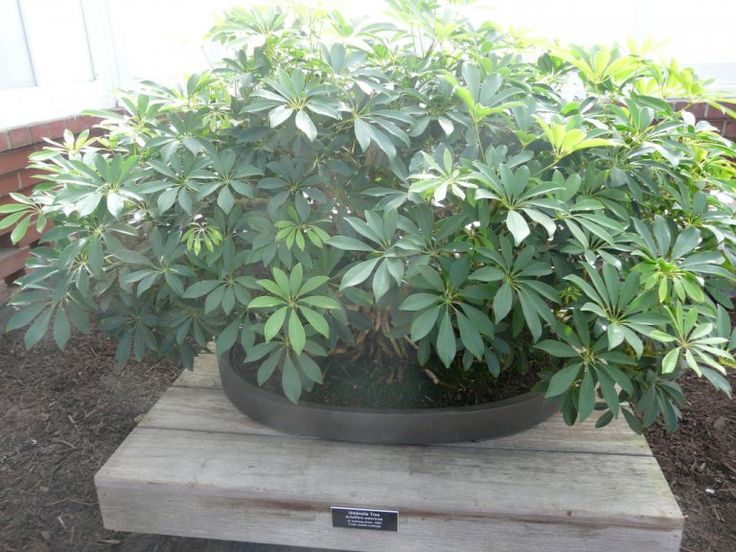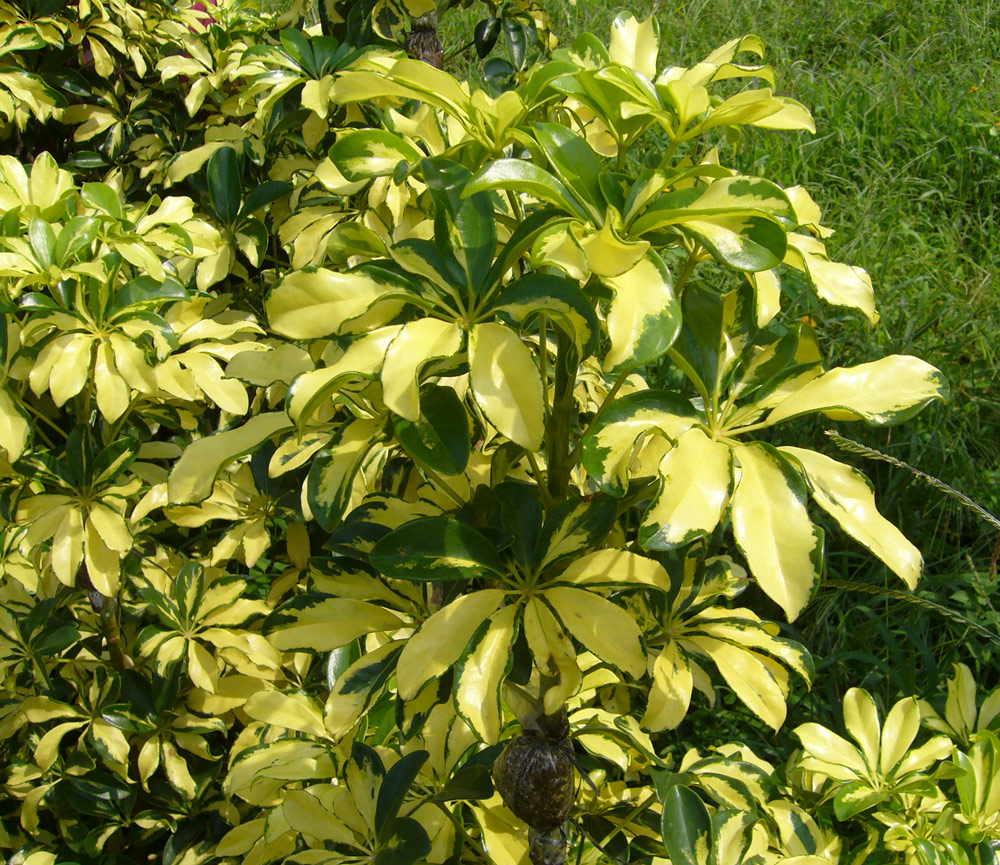Planting and care at home
As noted above, Schefflera is an unpretentious plant. But in order for him to be comfortable, so that she fully develops, it is necessary to satisfy some of her requirements.
Location, lighting
Schefflera is a light-loving plant. She needs light throughout the year, but she is afraid of direct sunlight. With a lack of light, the leaves will be faded, and direct sunlight can cause burns.
For Schefflera with dark green leaves, the most favorable place is the eastern, western and even northern windowsill. But for variegated species, a southern window sill is suitable, but with the obligatory shading.
To this day, there is no consensus on whether it is necessary to take the plant out into the fresh air during the warm season. A number of experts believe that this can be done, while others, on the contrary, are sure that this will only harm the plant. Here it is best to focus on the needs of the plant itself.
Temperature regime
Although Schefflera is a "southerner", she does not tolerate extreme heat well. The optimum air temperature in summer should be + 16-22 ° С, and in winter - + 14-16 ° С. For species with variegated leaves, the air temperature should not be less than + 18 ° C.
Watering Shefflers
It is recommended to put the Schefflera pot in a high tray. It is especially needed in the summer, when the plant needs regular abundant watering. The plant will absorb as much moisture as it needs. Excess water is drained, otherwise it can lead to rotting of the root system. The recommended frequency of watering is twice a week at the rate of 300 ml per 1 liter of soil. However, it all depends on the plant.
Soil composition
To make the plant comfortable, it is necessary to prepare a fertile, necessarily slightly acidic soil for it. It should consist of sod land (40%), leafy land (30%), humus (20%) and sand (10%). If it is not possible to prepare such a soil mixture, then you can purchase soil intended for palm trees.
Top dressing
Sheffler needs to be fed from March to September. The frequency of feeding is once a month. Use universal fertilizers intended for ornamental deciduous plants.
The plant also needs to be fed during the dormant period, but the fertilizer concentration should be halved. Apply fertilizer once a month.
Pruning Room Shefflers
Pruning is done in the spring by cutting off the tops of the plant. This will stop excessive growth, can add splendor, although Schefflera is not particularly willing to let side shoots. Pruning is carried out for 5-6 buds or more.
Pruning is necessary for the tree-like Scheffler, since with this procedure a beautiful crown can be formed.
Sheffler species
It is easy to recognize: the leaves are collected in the form of a flower and are directed radially like rays. It is surprising that in nature this is the most ordinary tree (up to 30 m tall), and the breeders have already got the domesticated version.
This type of sheffler is “crowned”: the Royal Horticultural Society has noted the radiant sheffler as an especially beautiful ornamental plant! This sheffler was helped not only by shiny green leaves of an interesting shape, but also by bizarre inflorescences.

Schefflera digitata
The name “7 fingers” was also assigned to this species. Indeed, 7 dissected leaves emerging from one point, resemble a palm
In nature, this is a low plant, to which the attention of botanists is now directed: the finger sheffler in natural habitat (and this is only New Zealand) is threatened with extinction
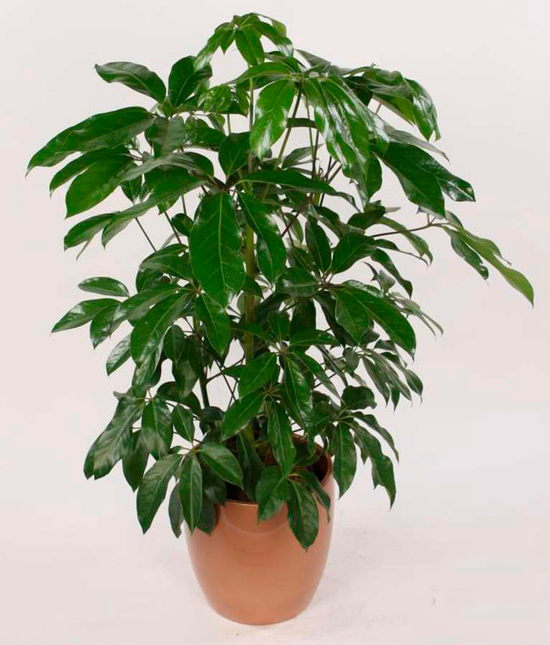
Schefflera octophylla
8 leaves on long petioles make it possible to recognize the eight-leafed sheffler and compare it with the tentacles of an octopus. It is noteworthy that most often the leaves of this type of shefflera are not dark green, but olive.
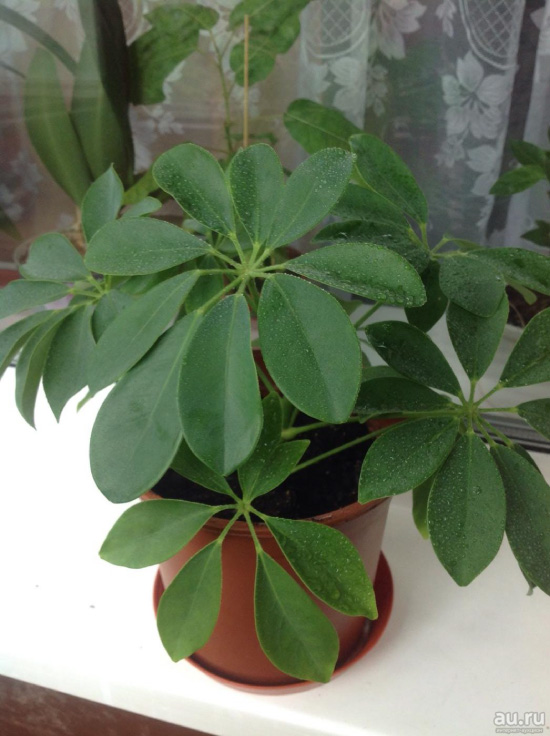
Schefflera arboricola
An ideal variety for lovers of unusual plant colors, as well as fans of the art of bonsai. It is the woody sheffler that has the greatest variety of variegated colors, and the ability of the tree to release aerial roots with proper care and the diligence of the owner will help create an amazing composition. The mini-tree will rise above the pots on its unusual roots and seem to float in the air!
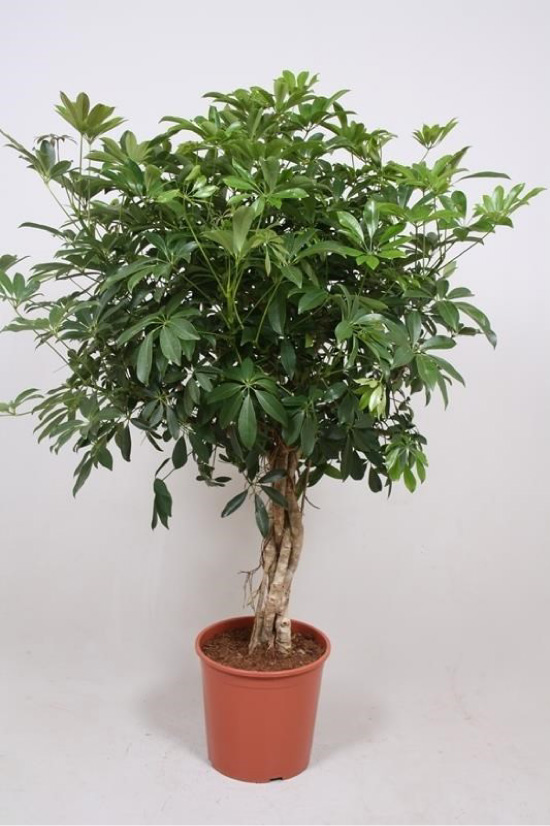
1. Seven Secrets of Success:
| 1. Growing temperature: throughout the year, a fairly cool content at a temperature of 16 - 18 degrees Celsius is suitable for shefflers. |
| 2. Lighting: brightly lit location shaded from direct sun. |
| 3. Watering and air humidity: in spring and summer dry the soil 2 - 3 centimeters deep before each subsequent watering, in winter just protect the earth from completely drying out if the plant is in a cool place. The air humidity is high enough. |
| 4. Pruning: Regularly pruning and pinching the tips of young shoots to form a compact and dense plant. |
| 5. Soil: a well-drained and nutritious substrate that easily permits moisture and air to the roots of the flower. |
| 6. Top dressing: from spring to autumn, they are monthly fed with mineral fertilizers for decorative leafy plants. |
| 7. Reproduction: by rooting stem and leaf cuttings, rarely by seeds. |
Botanical name: Schefflera.
Scheffler's home - family.
Homeland of the plant. Australia and Oceania.
What it looks like. The genus consists of about 900 evergreen shrubs, vines or short trees. Most indoor plants are shrubs with erect stems. With age, the stems become lignified and covered with light brown bark.
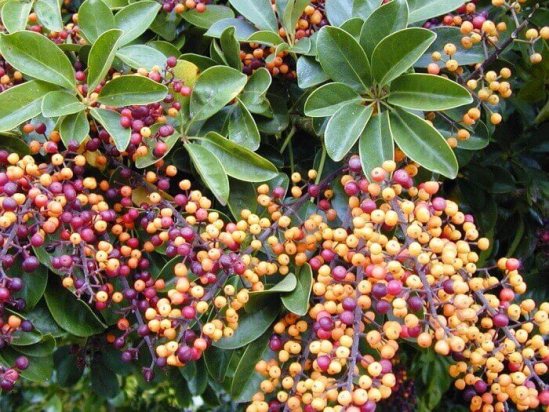
The complex leaves of shefflera have very long petioles and are arranged alternately on the stems. Leaves consist of oblong-oval segments arranged in a circle, the number of segments varies from 5 to 14. In green-leaved species, the leaves are monochromatic, variegated varieties are distinguished by the presence of white or yellow spots on the leaves.
In nature, shefflera throws out peduncles bearing many small, often reddish flowers. After flowering, the plant forms rounded berries.

Height. In its natural environment, the sheffler flower takes on impressive sizes and can reach 14 m in height. In indoor conditions, plants are pruned or low varieties are grown.
The size of the plants at home is also influenced by the volume of the pot - in cramped containers, plant development slows down.
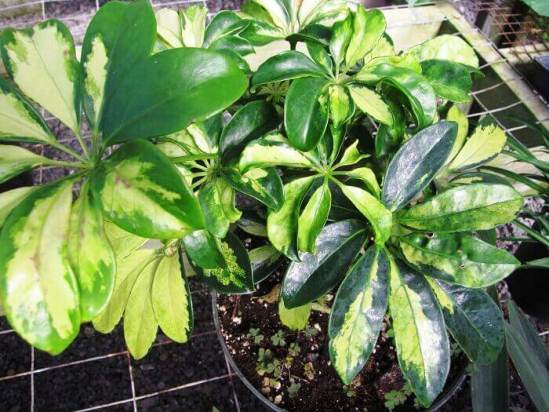
Shefflera care at home
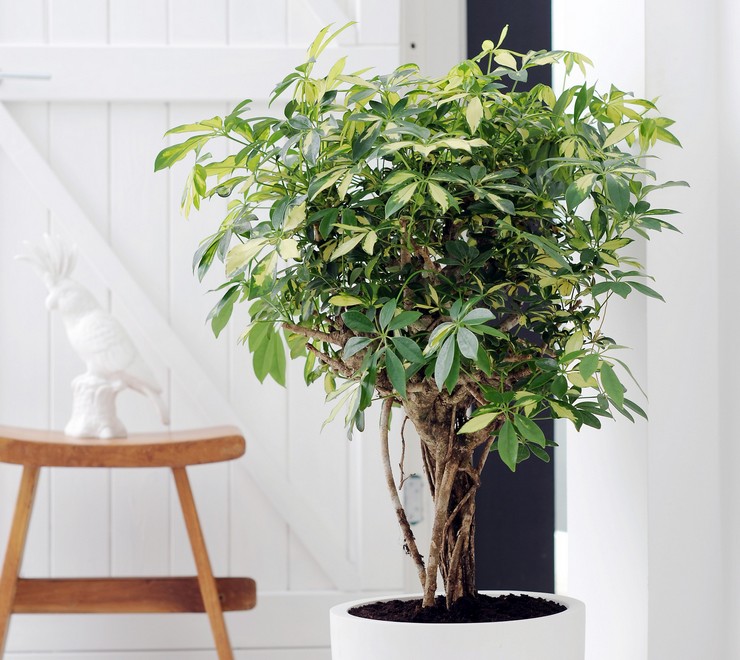
Location and lighting
The most ideal place for a chefler, where she will feel comfortable, are the sills of the windows facing east and west. The place of cultivation and the level of illumination depends on the selected variety and type of plant. For example, green-leaved varieties can grow on the windowsill on the north side, and variegated varieties on the east and west sides. The light should be bright, but diffused, without direct sunlight. In winter, more light is needed, therefore it is recommended to use additional lighting (artificial). Fluorescent lamps must be used (in autumn and winter) if the temperature in a room with indoor plants is above 18 degrees Celsius.
In the warm summer months, the sheffler will feel great outdoors in the garden or on the balcony, but in partial shade conditions, with protection from direct sunlight. You should know that drafts are categorically contraindicated for this plant. If you have a chefler with variegated leaves, then she will need more light than for a species with green leaves.
Temperature
The temperature regime for growing tropical shefflers varies depending on the season. For example, in the spring and summer months, the optimum temperature for full growth and development is 18-20 degrees. In the autumn and winter periods - 12-16 degrees Celsius, lower temperatures are dangerous to the health and life of a indoor flower
It is very important that during the heating season the plants are not near central heating radiators or other heaters.
It has long been noticed that in rooms with air conditioners, the plant grows much better and faster. But this does not mean that the pot with the plant should be placed under cold air jets.
Watering
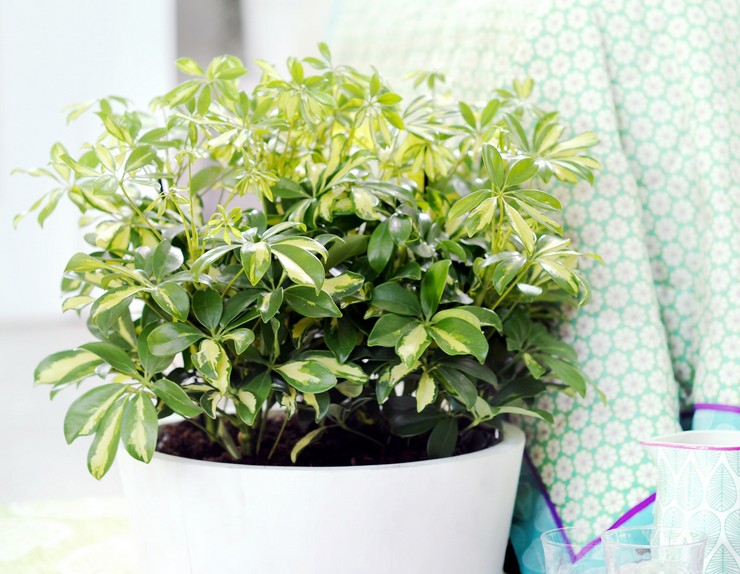
It is necessary to water the sheffler regularly, in summer and spring in moderate amounts, in the cold months - in minimal amounts. For irrigation, you need to use only soft, settled or purified water with a temperature close to room values. Overdrying the earthen coma will negatively affect the decorative qualities of the plant, and the constant excessive moisture of the soil can lead to its acidification and, in the future, to the death of the entire flower. The temperature readings of indoor air and soil in a flower pot should be approximately the same.
Sheffler can be grown using the hydroponic method.
Air humidity
Ornamental-leaved shefflera prefers high humidity. You can maintain such a high level using a special pallet with wet peat or expanded clay. Additional moisture is given to the plants by regular spraying. Such water procedures are carried out with soft, settled warm water with a temperature of 20-22 degrees Celsius 1-2 times a day.
The soil
The soil for growing shefflers should be light, slightly acidic. The composition of the most suitable substrate: one part of humus and fine-grained river sand and two parts of sod land. Another variation of the substrate: 3 parts of greenhouse or compost soil are mixed with 1 part of peat and 1.5 parts of coarse sand.
Top dressing and fertilizers
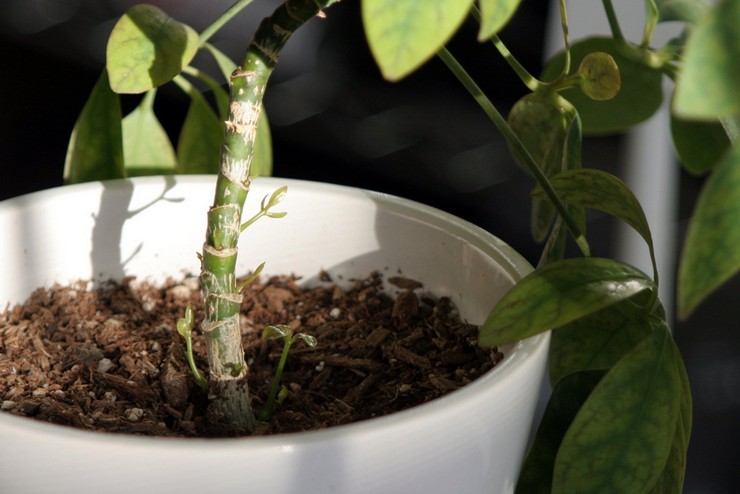
It is recommended to apply universal fertilizing for deciduous indoor plants regularly at intervals of two weeks throughout the entire growing season, from early spring to late autumn, along with watering.
Transfer
It is recommended to transplant shefflers in early spring every two years. The new flower pot should significantly exceed the volume of the previous one, because with proper care, the chef will grow rapidly. A good drainage must be laid on the bottom with a layer of 2-4 centimeters.
Pruning
Schefflera reacts negatively to pruning, and its decorative qualities suffer from this procedure. To create a lush and dense shrub, it is recommended to plant several seedlings in one flower container at once.
Room Schefflera Care
Sheffler flower is not picky about care, but still prefers comfort
She perfectly takes root in a modern apartment, if you provide her with the necessary care and attention.
Where to place the shefflera pot
The most suitable place for a comfortable stay of this tropical guest will be the window sills of the east and west windows. The plant prefers bright places, but categorically does not accept direct sunlight
It is very important to ensure good air circulation in the room, but at the same time it is necessary to keep the planter with the shefflera away from drafts
Temperature and humidity
Too high temperatures are harmful to the shefflers. Ideally, in the summer months it is possible to maintain the temperature at + 18 + 22 degrees. This is possible if the room is equipped with air conditioning, but it is not worth placing the plant under air currents. It has been noticed that the Scheffler grows and develops much faster in air-conditioned rooms.
Considering that the tropics are the homeland of this plant, it becomes clear that the sheffler needs to ensure a high humidity of the environment, for which the pot with the plant is placed in a pallet with wet expanded clay. Regular spraying with settled soft water will also be useful. In winter, if the temperature of the content is the same as in summer, spraying is not canceled.
Lighting
Schefflera is a light-loving plant, and variegated forms have a great need for good lighting. In winter and autumn, it is advisable to rearrange the flower pot to the south side, creating diffused light with the help of light shading. With insufficient lighting, the shrub begins to wither and wither.
Watering
One of the important conditions for the successful cultivation of shefflers is the observance of the correct watering regime. The plant does not tolerate excess moisture, the stagnation of which leads to the appearance of putrefactive processes in the root system. Watering the green inhabitant should be moderate, but the earthen coma should not be allowed to dry out either.
Water for irrigation needs soft, settled water, the water temperature must correspond to the temperature of the soil. Reduce watering during the winter months.
Top dressing
Fertilize the sheffler during the period of active growth, that is, from spring to autumn, on average, once every 10 days. To do this, use a solution of universal fertilizer for decorative deciduous plants, sometimes alternating it with organic feeding.
Transplanting an umbrella tree
Young plants need replanting once a year. The transplant is carried out at the beginning of spring, in a pot much larger than the previous one. It is necessary to provide the plant with good drainage, for which a layer of expanded clay is laid on the bottom of the pot. The transplant soil is used with the following composition:
- turf (2 parts);
- sheet (1 part);
- humus (part 1);
- sand (1 part).
An adult plant is transplanted by the transshipment method every few years, trying not to disturb the earthen ball and not to damage the roots. If the shefflera has grown to a very large size, you can limit yourself to replacing the topsoil.
Pruning
To get a beautiful lush tree, it is necessary to trim the top of the shefflera from time to time, after which the plant will release new side shoots. Thus, a spherical volumetric crown will be formed, giving the plant a more decorative appearance. It is also possible to form a treelike crown by cutting off the lateral and lower shoots.
Description of the types and varieties of shefflera
Representatives of this genus are shrubs, lianas and trees, with a height of the aboveground part up to 2.5 m. The foliage is complex, dissected into lobes. With age, the trunk is bare, and the foliage remains only at the top. Flowering paniculate or racemose inflorescences. The most unpretentious is the "Plant Mix" variety.
Schefflera variegated
The most popular variegated forms are represented by the varieties Gerda, Sophia, Trinette and Gold Сarella. Spots on a green background can be yellowish or white. They differ in leaf size, but all have a very high decorative appeal.
Scheffler's finger
S.digitata is a small shrub-like plant that is ideal for beginner growers. Leaves are represented by several lobes, the number of which can be ten. The foliage is elliptical in shape, with very characteristic cusps at the ends.
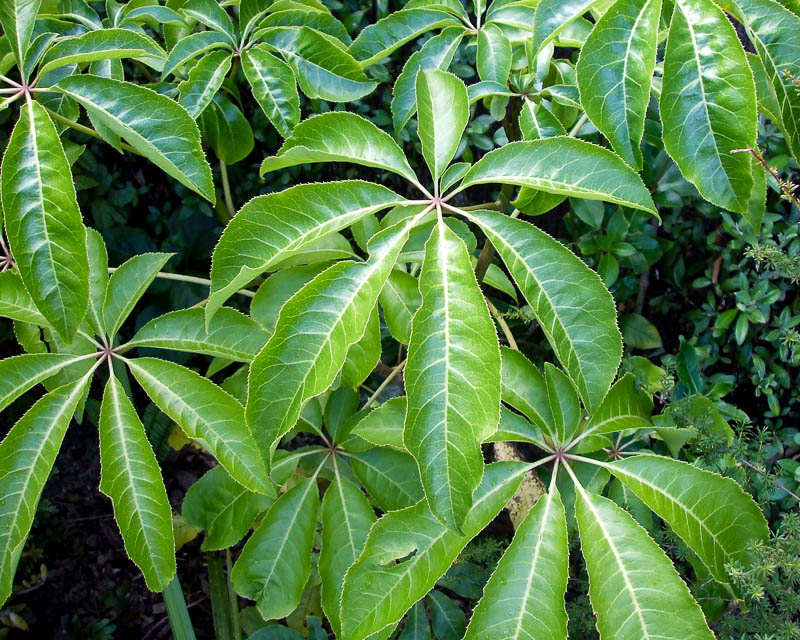
Scheffler's finger
Schefflera eight-leaf
S. estorhylla - has leaves, in which the number of lobes can vary from five to sixteen. This variety is known to many growers as an octopus tree. Lobes are oval, on an individual petiole. Young foliage often has sparsely jagged or feathery edges. Flowering in November or early December, after which the plant begins to form fruits.
Schefflera woody (tree-like)
S. arboricol is the most common variety in home floriculture. The tree-like Heptapleurum is characterized by an appearance that resembles a liana without branches, as well as a significant amount of growth formed from the root system. The most popular varieties of this variety are Variegata with dark green leaves and yellow spots, and Janine with dark green leaves and cream stripes or spots.

Schefflera woody (tree-like)
Schefflera radiant (star-leaved)
S.astinorhylla is an independent species with a height of the aboveground part of just over ten meters. It has a powerful and erect trunk with a thickening at the base. Leaves on long stalks of red-brown coloration. The leaf plate is green, glossy, with slightly wavy edges. Inflorescences are represented by red flowers.
Schefflera Nora
S. Nora is an indoor variety with elegant foliage and unpretentious care. It has very long and narrow dark green leaves with yellow dots. The edges of the leaf plate have smooth serrations. The crown is very lush, well leafy.

Schefflera Nora
Scheffler Custer
S.Kasterа is a short and fairly compact variety, which is highly valued by amateur flower growers and is optimal for growing in small apartments. Differs in attractive appearance and unpretentiousness.
Scheffler Louisiana
S.luiziana is one of the most graceful varieties with very decorative and delicate, leathery and shiny leaves. The leaf plate is variegated, with quite numerous splashes of white or yellow color.
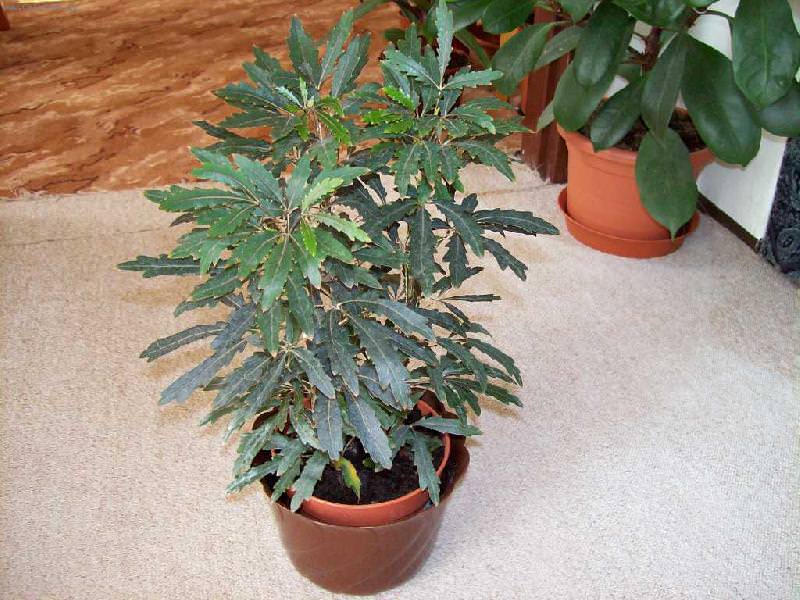
Scheffler Custer
Scheffler Gerd
Treelike variety with very decorative, lush greenery, bright green or yellowish green leaves. For full-fledged cultivation and preservation of all the external attractiveness, the plant requires a large amount of diffused lighting, so the flower pot should be kept on windows with diffused light.
Transparent relative of ordinary sheffler
Sheffler is the most graceful of most flower growers known under the old name - elegant dizygotheca (Dizygotheca elegantissima) and the popular nickname of false castor bean. In the genus Scheffler there are many plants that are loved by flower growers all over the world and firmly hold their positions in the ranking of large indoor giants. But shefflers are classic and popular - the plants are massive, and, although quite beautiful, they are still not original. But one unique species of this genus seems to be no less, perhaps, than an exceptional exotic. Schefflera elegantissima is a unique plant both in silhouette, in its influence on the interior, and in character.
It is one of the most elegant large-scale indoor crops. Despite the fact that the sheffler bushes can reach one and a half meters and are quite voluminous, it seems weightless, transparent and devoid of the unpleasant ability of its fellows to visually reduce space and suppress the environment. The airiness of the shefflers acts quite the opposite, it gives the rooms a sense of freedom and additional space. The plant seems to compensate for heavy and massive objects.
But the main thing in the graceful sheffler is its ultra-modern, unusual, graphic and slightly defiant appearance. This plant is suitable for modern interiors with their play of colors, textures and textures, for the setting in which such a graphic plant can be appreciated.
Tall stems, upright, slender, spotted, form an airy tree. The thin, densely branching shoots of the sheffler are difficult to distinguish from its leaves from a distance; narrow lanceolate leaves with a serrated, coarsely toothed edge and up to 40 cm long with a width of less than 1 cm are folded in 5-10 pieces. in palmate-compound leaves; but such a structure is not easy to assess both because of the subtlety of the lobes themselves, and because of the long petioles (up to 40 cm).On the shoots, the leaves are arranged alternately. The older the plant, the less pronounced the finger-like shape of the leaves and the more chaotic their structure.
Shefflera, graceful, unlike her fellows, cannot boast of a large palette of colors. In this indoor culture, the leaves are colored only in a rich dark green color, which seems almost dark when placed in front of a window in the interior. The plant pleasantly surprises with the bronze color of young leaves, on which the scarlet midrib stands out brightly.
In the indoor conditions of the Scheffler, the most graceful one does not bloom, and in greenhouses it is not often possible to admire the apical umbrellas of the inflorescences.
On sale you can find both the base plant and the three most popular varieties of shefflera of the most graceful:
- ‘Castor’ - with smaller and wider lobes of three-toed leaves;
- ‘Bianca’ is a light green cultivar with a cream border along the edge of the shortened wide lobes;
- 'Gemini' - with ovoid leaves of a dark color with a reddish vein.
But these plants are still less graceful than the ordinary shefflera elegantissima.
 Schefflera elegantissima. floradania
Schefflera elegantissima. floradania
Transfer
From time to time, the sheffler needs to be transplanted. On average, this procedure is performed every 2-3 years. It's time to change the pot when the roots start to stick out from the top of the soil or from the drainage holes.
The best time to transplant is early spring.
First, carefully remove the plant from the pot. If it does not give in, it is worth lightly watering the soil and walking with a sharp knife along the edge of the container.
After carefully remove the old substrate from the roots, examine for the presence of old, damaged, rotten roots, which will need to be removed at this stage. You can carry out a preventive treatment with a fungicide.
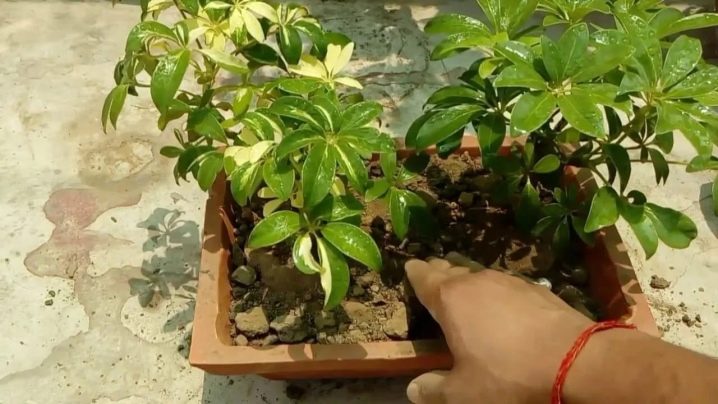
The new pot should only be slightly larger than the old one, on average 5 cm in diameter. Drainage is organized from small pebbles or brick chips at the bottom of the tank, it is he who will ensure the removal of excessive amounts of water during irrigation. On top of this layer, the prepared substrate is poured to the middle, the flower is set, the rest of the soil is added, after which it is lightly pressed on the soil, then watered.
Step by step, this process can be represented as follows.
- Before transplanting, in a few days, you need to make high-quality watering of the plant, and in a few weeks you need to fertilize so that the flower gains strength and does not experience a strong shock.
- First, you need to prune dead and diseased stems, which are often the cause of bacterial and fungal diseases. If the crown is too large and you want to make it more compact, you can remove the extra shoots. Cut the stems in half to stimulate new growth.
- They take the sheffler out of the container by turning it upside down, but holding the bush by the trunk at the base of the soil.
- Remove dead or rotten roots with sharp pruning shears or scissors. The smoother the cut, the better the wound will heal. You can treat it with a solution of activated carbon.
- In an already prepared new pot with drainage and the first part of the soil, the sheffler is placed in the center so that the root ball is located at the level of the edges of the container.
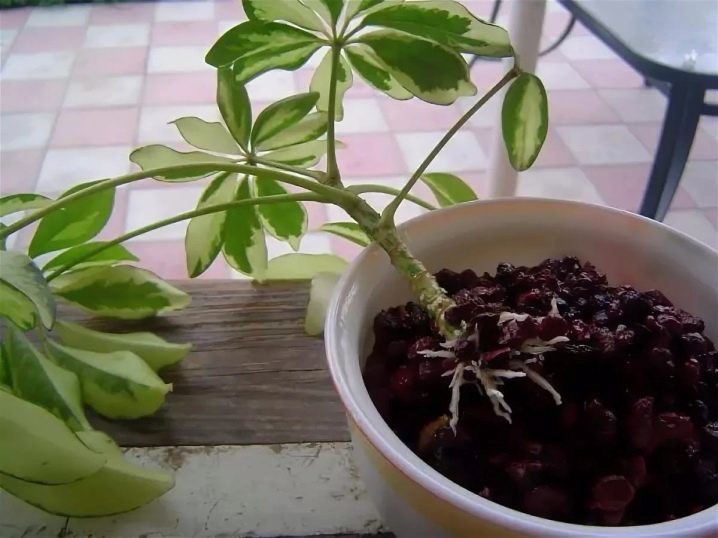
Some inexperienced growers do not understand why fertilizers cannot be applied after transplanting, because they help the flower to gain growth and green mass faster. This is precisely the main problem, because after pruning, the roots need to develop a full-fledged system again, otherwise they simply will not cope with providing a large plant with the necessary minerals and water.
Temperature
The room temperature is quite suitable for the plant, so that it can comfortably coexist with you in an apartment.
In the cold season, the Schefflera does not mind lowering the temperature to 16 degrees, but not colder.
Like other indoor plants, the bush must be protected from drafts and the proximity of heating appliances.
Watering
Schefflera will remind you of watering itself - as soon as the top layer dries up, then watering is required. Sheffler can easily ruin both overflowing and drying out, so keep a balance and watch her.
An approximate watering schedule in the warm season is every two days. In winter - moderate watering every 5-7 days.
Focus on the conditions of the plant, because the soil dries out faster or slower in different houses.
You can use a life hack: install the pot on a pallet with expanded clay, periodically watering the stones. The necessary moisture will rise to the ground, and the excess will evaporate.
Important: for watering all indoor plants, you need to use only settled water at room temperature. Watering directly from a cold tap can quickly take a toll on plant health.
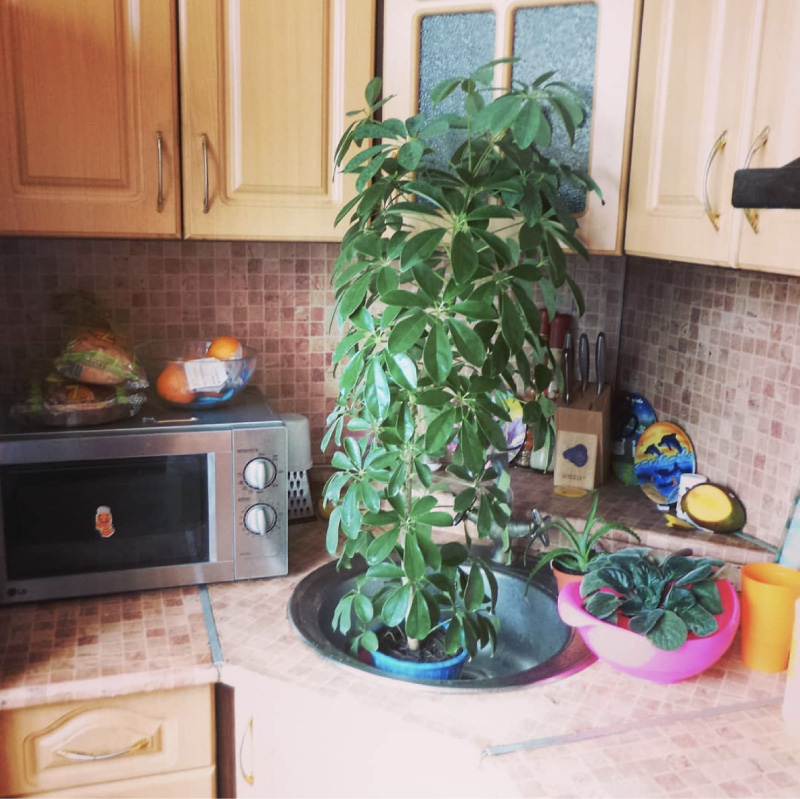
Pests and diseases chiefs
Sheflera turns yellow
With improper or insufficient care, the chef is affected by scale insects, red spider mites and thrips. As a result of the vital activity of these insects, the plant loses its decorative effect: the leaves of the cheflera turn yellow, its growth slows down, and in the end it dies. To avoid the death of the plant from insects, regularly inspect the chefler, and when the first pests appear, remove them from the plant with a cloth or cotton swab dipped in soapy water. If you missed their appearance, and they have already occupied the plant, treat the chefler with a solution of Karbofos or Actellik (15-20 drops per 1 liter of water), just make sure that no chemicals get into the ground. With a very strong pest infestation, the treatment will have to be repeated after two weeks.
Yellow spots on the chefler appear from too bright light. Move the plant to the back of the room or shade it out of direct sunlight with a curtain.
Sheflera drops leaves
It happens that there are no pests on the plant, but, nevertheless, the shefler crumbles. Why does the shefler fall? The reason for the leaves falling off in the cheflera may lie in uncomfortable conditions for the plant. For example, if the room temperature is below 14 or above 30 ºC for a long time. Or in the case when its roots rot from chronic waterlogging.
How to save the boss from death in this case? It is necessary to remove it from the pot, carefully remove the rotten areas of the roots, then lower the roots of the chefler into the solution of Epin or Zircon, then treat them with Fitosporin or sprinkle with crushed coal, transplant into a fresh moist substrate and put a transparent plastic bag on the plant, sometimes removing it for ventilation and soil moistening. Finally, the package can be removed in 5-7 days
Sometimes cheflera leaves fall off due to insufficient lighting, variegated plant forms especially suffer from this.
Sheflera turns black
Often readers complain that the leaves of the chefs turn black, starting from the tips. This usually happens when the room humidity is low or due to poor watering. Correct these deficiencies in the care, and gradually the plant will regain its shape.
The value of chefs in folk signs
Many popular superstitions are closely related to this houseplant. There is an opinion that the flower is a real "kind vampire", absorbing the negative energy of those around.
Indeed, many growers have noticed the positive influence of this plant. It is credited to the chefler's ability:
- harmonize the atmosphere around you;
- remove the negative;
- stop quarrels between family members.
It is best to put a pot of green "helper" in your sleeping bag. Plant energy:
- strengthens sleep;
- will improve the relationship between spouses.
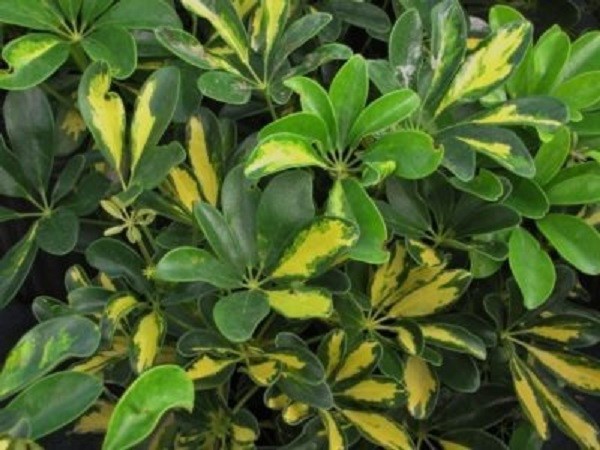
Sheflera can add a pinch of harmony to your life.
In addition, there is an opinion that if you carefully observe a flower, you can draw a logical connection between changes in its appearance and events in the life of the family:
- if the leaves began to darken, a lot of negative energy has accumulated in the house;
- if the leaves begin to fall off, one of the family members may become seriously ill;
- a sharp drop of foliage often means serious financial losses;
- when the leaves began to wrap, there will be a quarrel between friends, family members, colleagues;
- when the plant began to actively grow, and then these processes stopped - you need to prepare for failures in work, with loved ones;
- Shefflers associate rapid growth with future pregnancy.
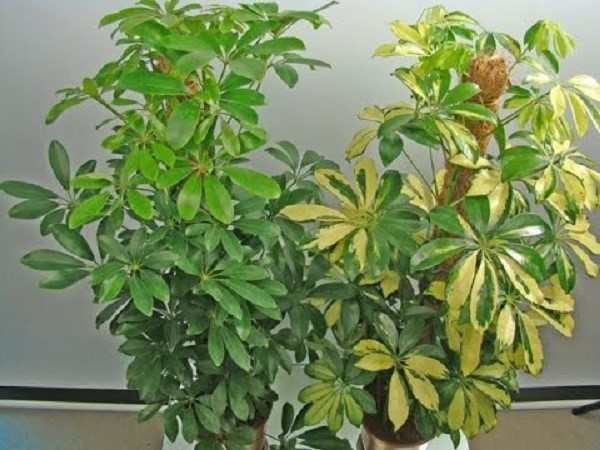
We believe that the chef will bring joy and good luck to its owner!
Problems, diseases and pests in the flower
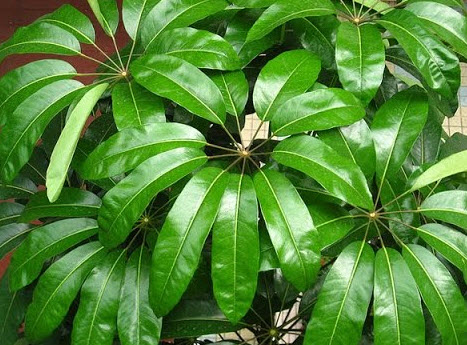
Any violation of the natural conditions of the sheffler will affect its appearance: insufficient lighting will be indicated by pale and faded leaves or twisting of trunks, the wrong temperature regime will give itself out by falling leaves. Slow growth means a lack of nutrients.
A weakened sheffler can also be interfered with by pests: aphids, spider mites and scale insects.
In the event that you noticed, the leaves became sticky, as if covered with a sweet film, you should know: this is aphid.
Plant diseases are treated with sprays with soapy water or commercially available herbicides.
The attack of a spider mite is easy to spot by the thin cobwebs on and around the leaves. Karbofos - will help get rid of this scourge. But remember that the tick is ubiquitous and cunning. He can hide in hard-to-reach places, for example, in the axils of the leaves or under them.
The main rule: the infected individual must be isolated from the rest !!
Aphids and ticks are afraid of common mustard infusions. Recipe: take 50 g of dry mustard, insist in 6 liters of warm water for 3 days. Then dilute to two buckets and wipe, as well as spray the plant 2-3 times a day.
Florist tips
The plant, which belongs to the exotic genus, looks elegant, but has some peculiarities in its care. The photos of the flower cheflers, which are in the article, confirm its luxurious appearance. To keep the plant like this, experienced flower lovers advise:
- When buying an adult plant, choose a specimen with bright foliage and polished skin.
- When planting a flower in a new place, use soil designed for palm trees. It is rich in trace elements and is well suited for chefs.
- The pot should be large so that the roots are freely located in it and the plant grows large. But do not overdo it, extra space is also undesirable.
- When pests appear: spider mites and scale insects, remove them by hand using a cotton swab dipped in soapy water. "Karbofos" is used for severe damage.
- If the plant begins to shed its leaves, the soil may have become waterlogged. It is necessary to remove it from the pot and carefully examine the roots. Remove rot, treat the cut sites with activated carbon and place in new soil.
To make an indoor flower look good and pleasing to the eye, take proper care of it.


